Public Pier — No Fishing License Required
My first visit to this pier took place on a sultry summer night in the mid-1970s. I was visiting southern California with my family, shepherding my wife and kids to the “must see” tourist spots during the day, and making short excursions to the local piers during the morning and evening hours. Much to my surprise, anglers at this pier were using drop-lights to fish. These lights consisted of a heavy electrical cord with a plug at one end and a light with a reflector at the other end. Fishermen would plug their lights into the electrical outlets located on the pier’s overhead lights. They would then lower their cords and lights down so that the drop-lights were just above the surface of the water. Inevitably, small fish such as anchovies and smelt were attracted to the lights and would swarm near the top of the water. Every so often a larger fish would approach, the small fish would scatter and disappear, and then, a few moments later, fish would reappear. Anglers, using light lines and small baits, were catching their share of the larger fish.
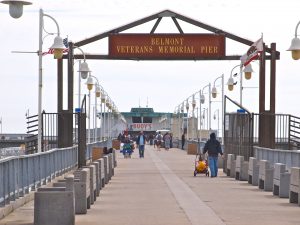
One couple allowed me to share their light and I quickly caught a small sand bass followed by several tomcod (white croaker) and mid-sized herring (queenfish). I didn’t have a drop-light but vowed that when I returned, I would bring one with me. Unfortunately, I waited too long, the electrical outlets were removed in the ’80s (due, the authorities said, to the fact that the outlets encouraged all-night camping and fires, which the campers set to keep warm).
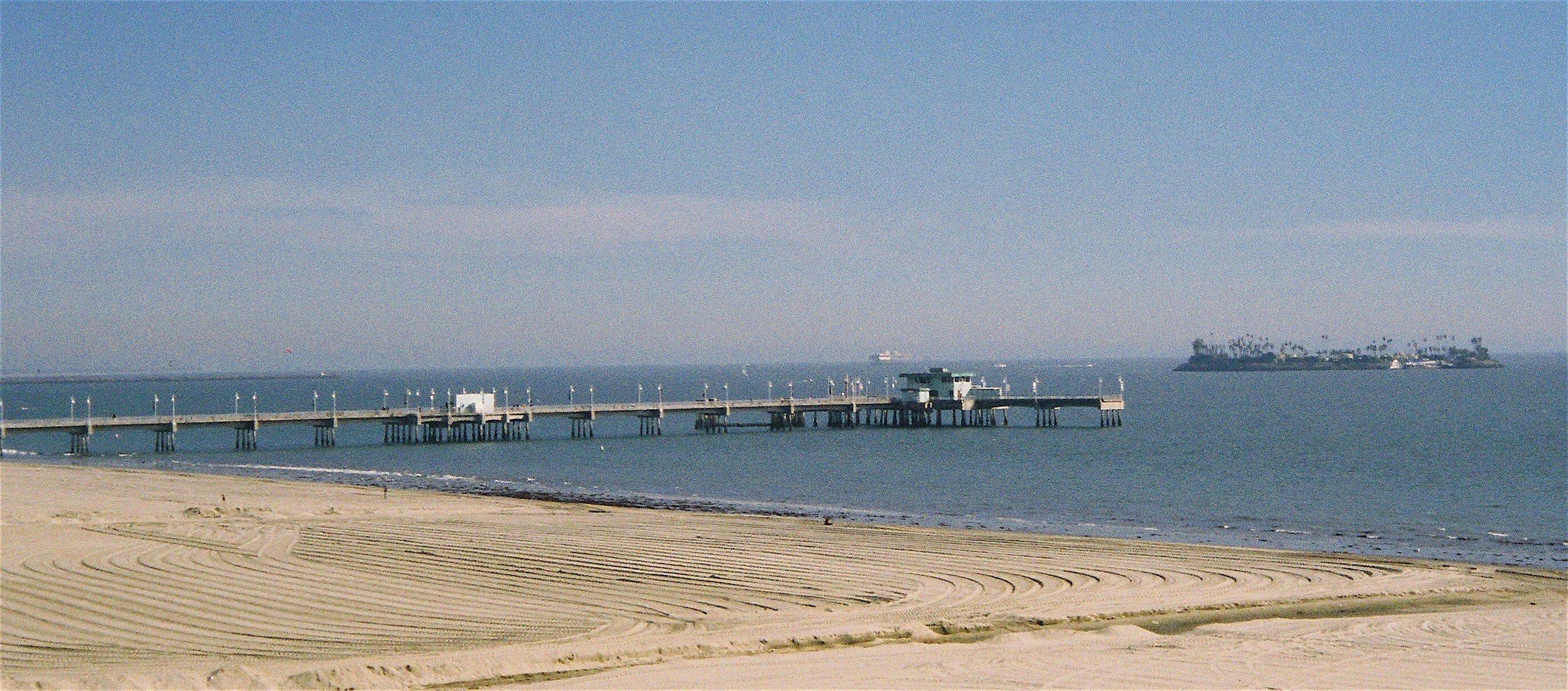
Nevertheless, even without drop-lights, I’ve generally caught some type of fish whenever I’ve visited the pier. The pier receives heavy use from anglers and, with the exception or “red tide” occurrences, generally yields at least a few fish. Having said that, the term “few fish” also somewhat reflects the fishing at the pier, it ranks near the bottom of Los Angeles County piers in my personal fish per hour statistics at 4.20 fish per hour. At the same time my records show 56 different species of fish being caught at the pier, the 12th highest variety among California piers. Yin and Yang.
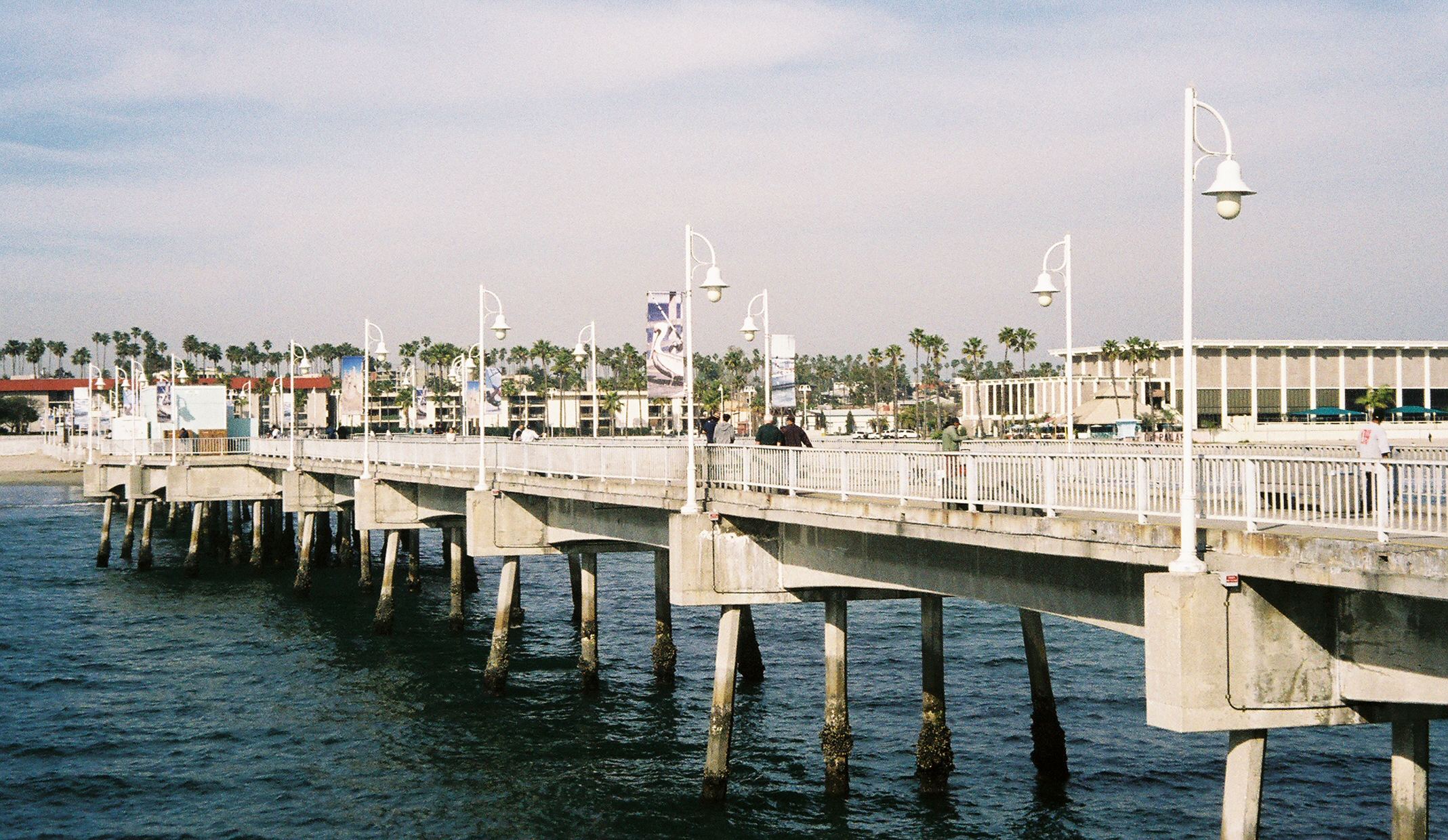
Environment. The 1,620-foot-long, T-shaped pier sits on a wide, sandy stretch of the Long Beach City Beach known as Belmont Shore (called “Horny Corners” by locals and no, I don’t know why). Given protection by the Long Beach-San Pedro breakwaters, this inner flank of Alamitos Bay typically sees calm waters with moderate surf. Further out and around the end of the pier the bottom is sand and mud. This area usually shows little growth of seaweed or kelp, but does have a fairly heavy growth of mussels on the pilings. In addition, concrete rubble was placed among the pilings during the construction of the pier (in 1967) to act as an artificial reef.
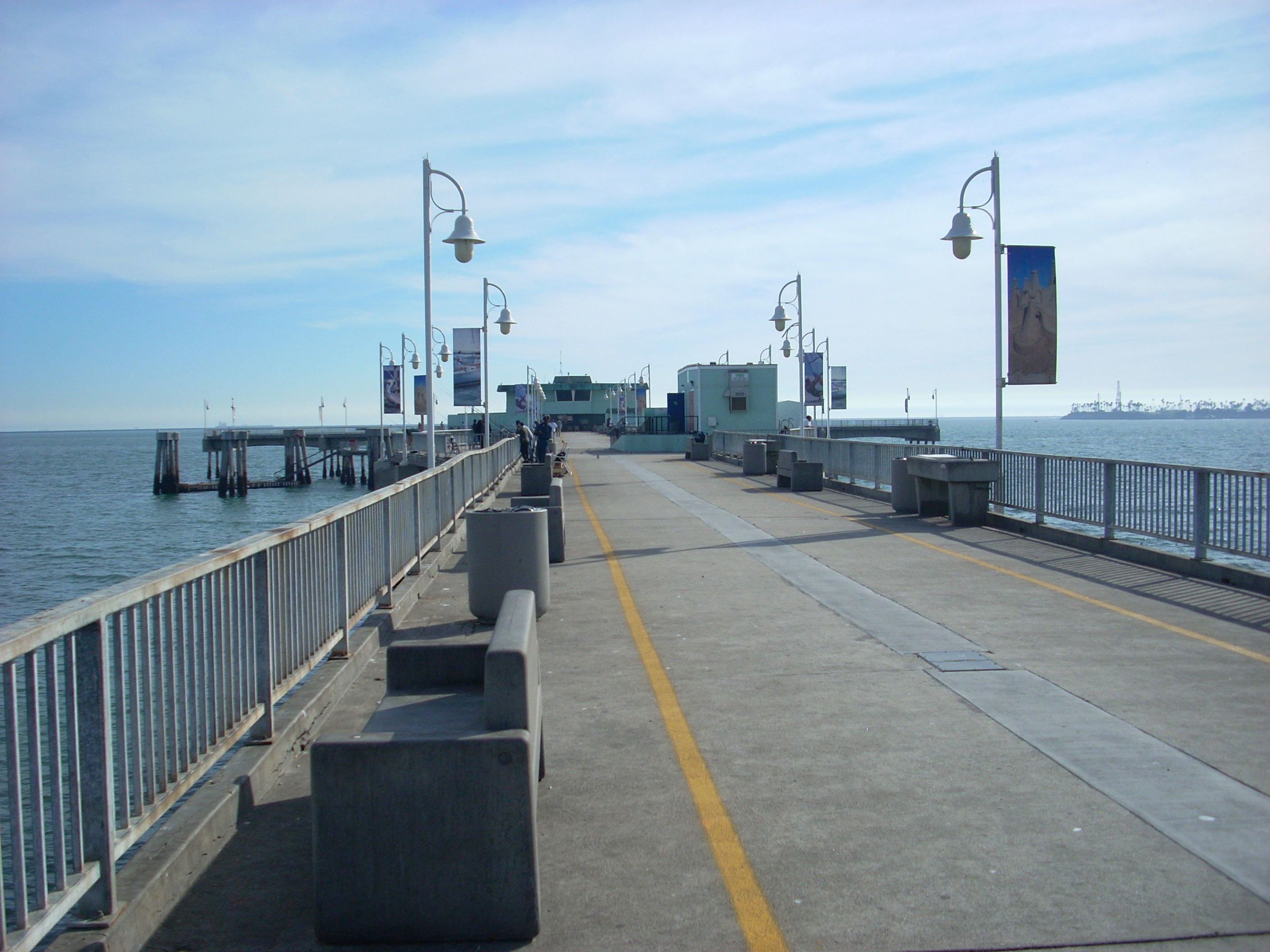
A negative aspect of the pier is fairly common red tide conditions (when fish will be virtually absent); at least a third of my visits in the past couple of decades have seen the pier surrounded, or nearly surrounded, by red tide.
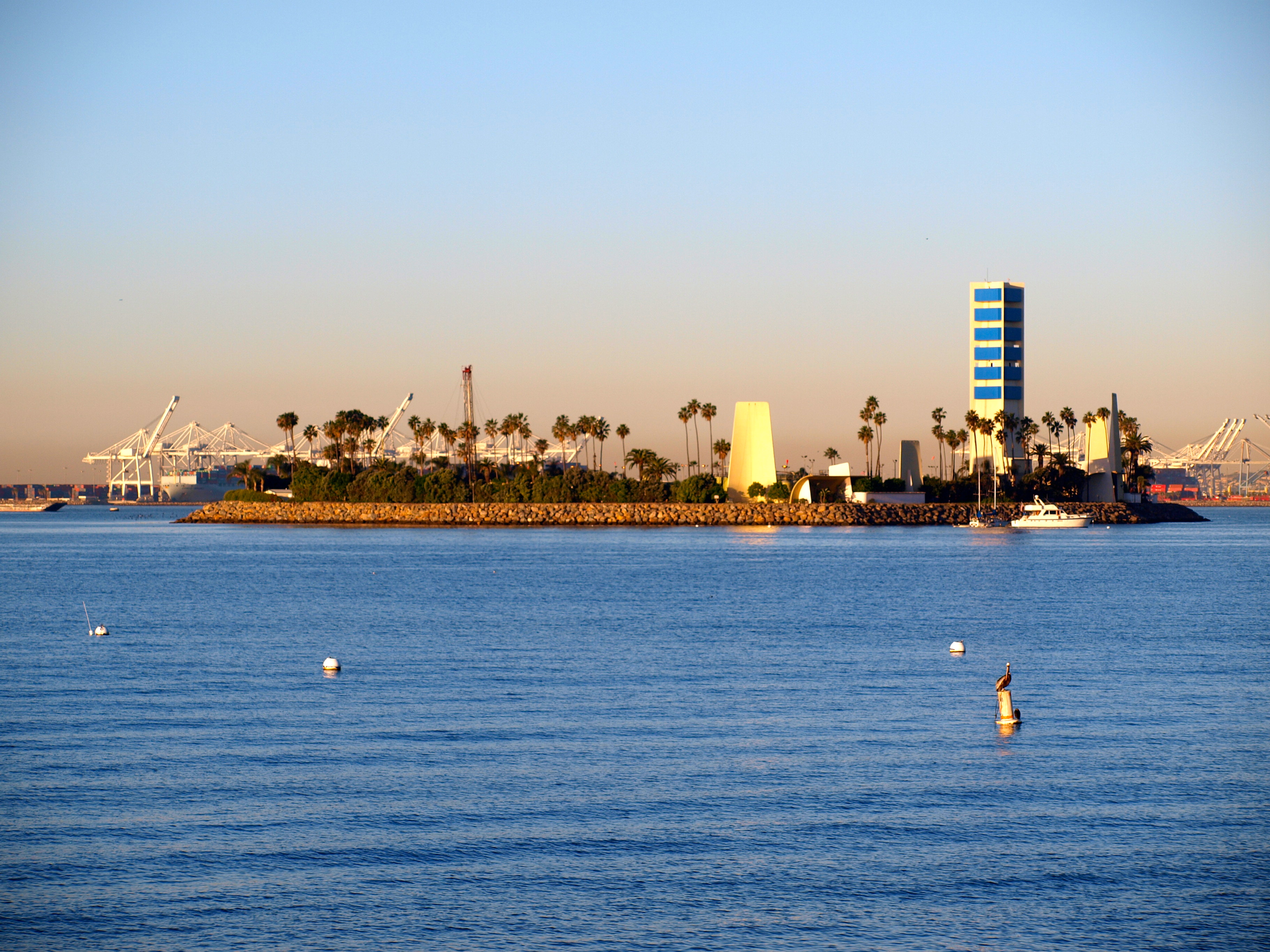
An interesting visual is the group of “Astronaut Islands” that sit a short distance offshore from the pier. Island Chaffee, Island Grissom, Island White and Island Freeman (named for the four astronauts who lost their lives on Apollo I) are artificial islands containing oil-drilling equipment.
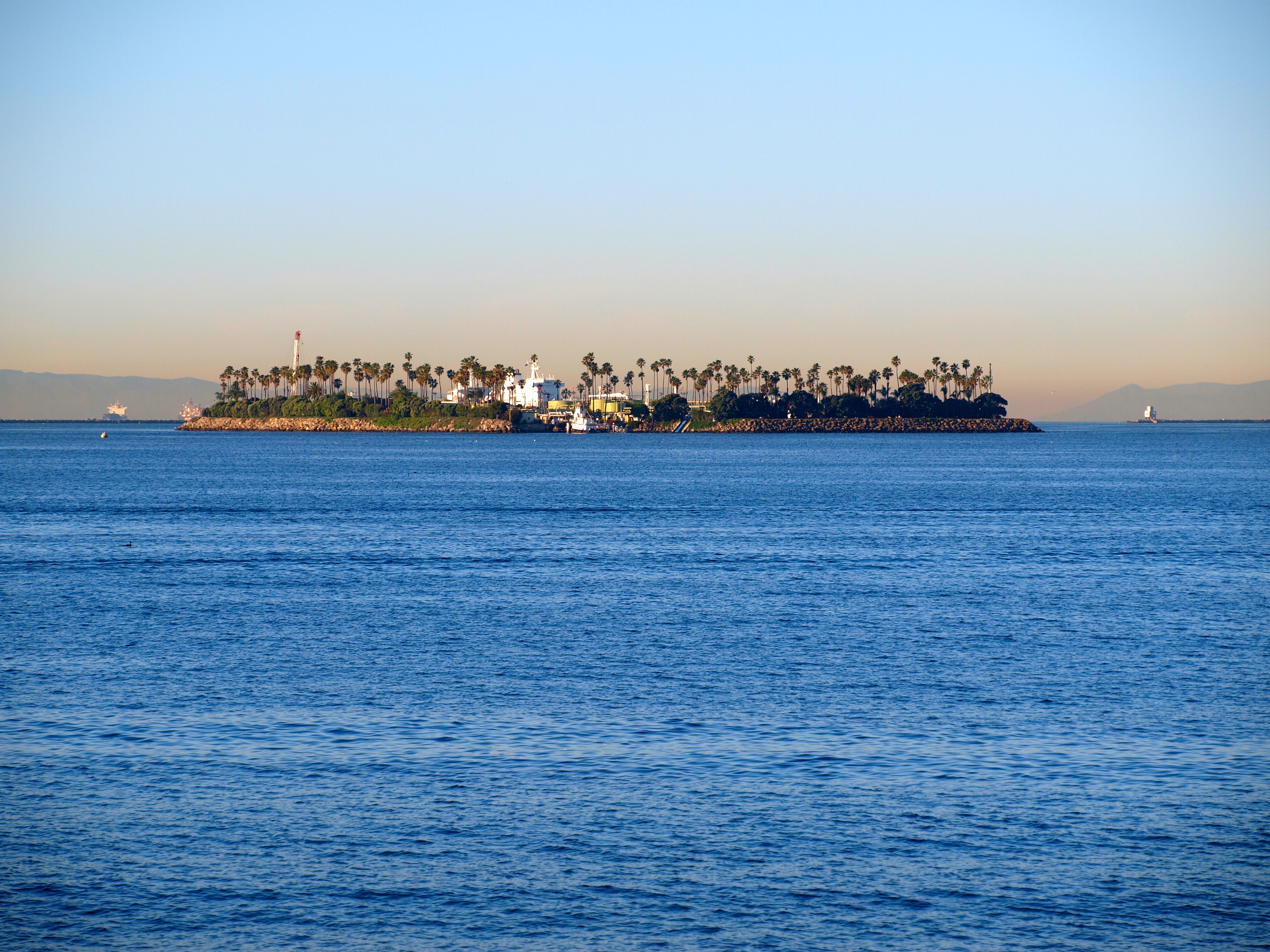
The islands were designed and decorated to appear as resort destinations and are sheathed in pastel-colored, modernistic-style walls that cloak their industrial activity. They are illuminated and landscaped with miniature plants that attempt to create an illusion of being further out to sea. Society wants the oil but doesn’t want to see the activity that produces it.
Societal priorities also change. The next question is if the pier will be closed and/or rebuilt. [See the final article at the bottom.]
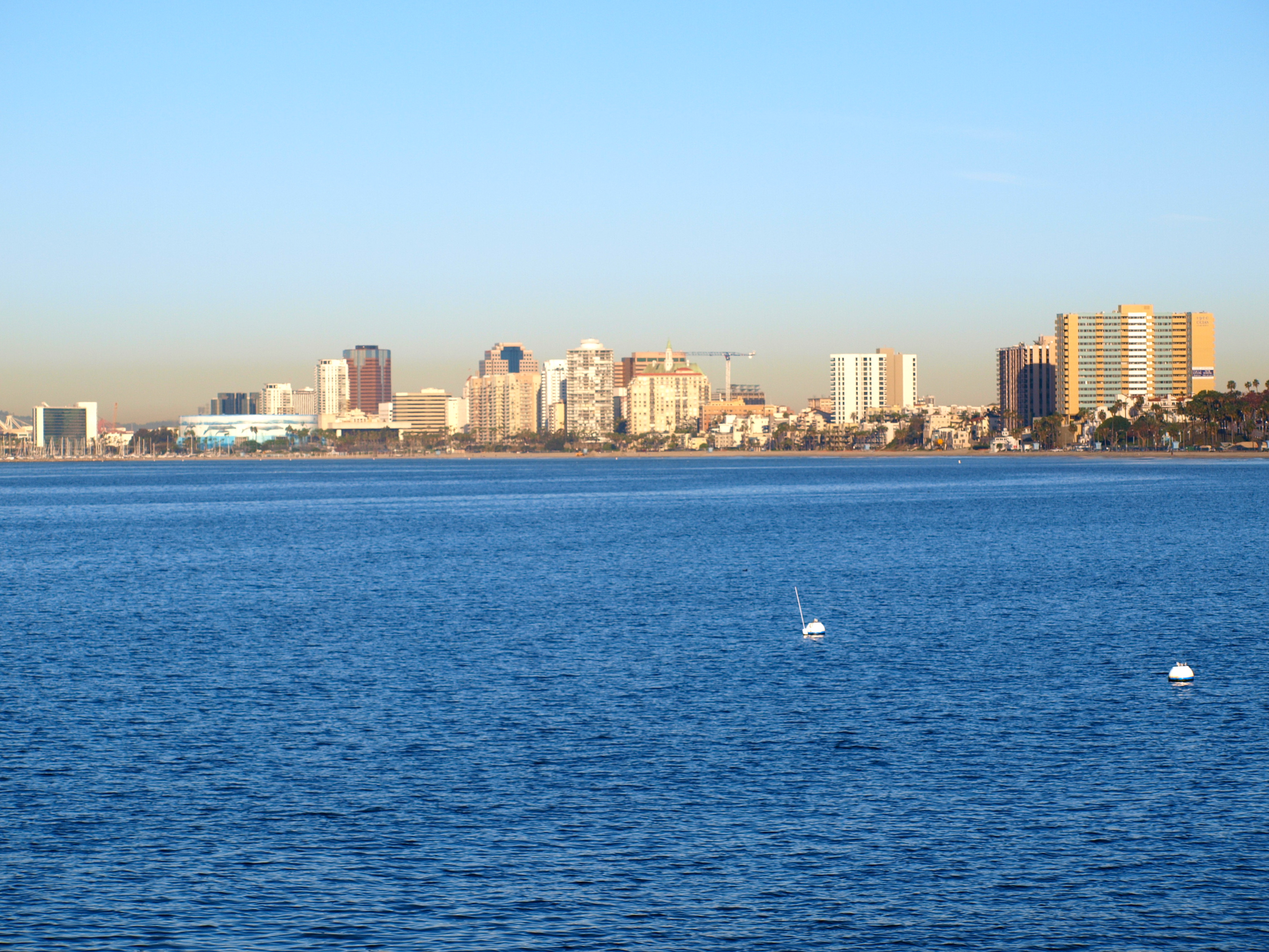
Downtown Long Beach
The Fish and Fishing Tips. The pier has at times above-average surf fishing yielding corbina, spotfin croaker, yellowfin croaker, barred surfperch, round stingray, thornback rays and guitarfish (shovelnose sharks). Midway out on the concrete pier is the best area for halibut and sand bass, as well as the smaller walleye surfperch, jacksmelt, tom cod (white croaker) and diamond turbot (some years sees fairly good runs of the small flatfish, especially in February or March). This mid-pier area will also yield good numbers of croakers but not in the numbers of the inshore area. The areas near the bait shop and the boat landing seem best for sargo and herring (queenfish).
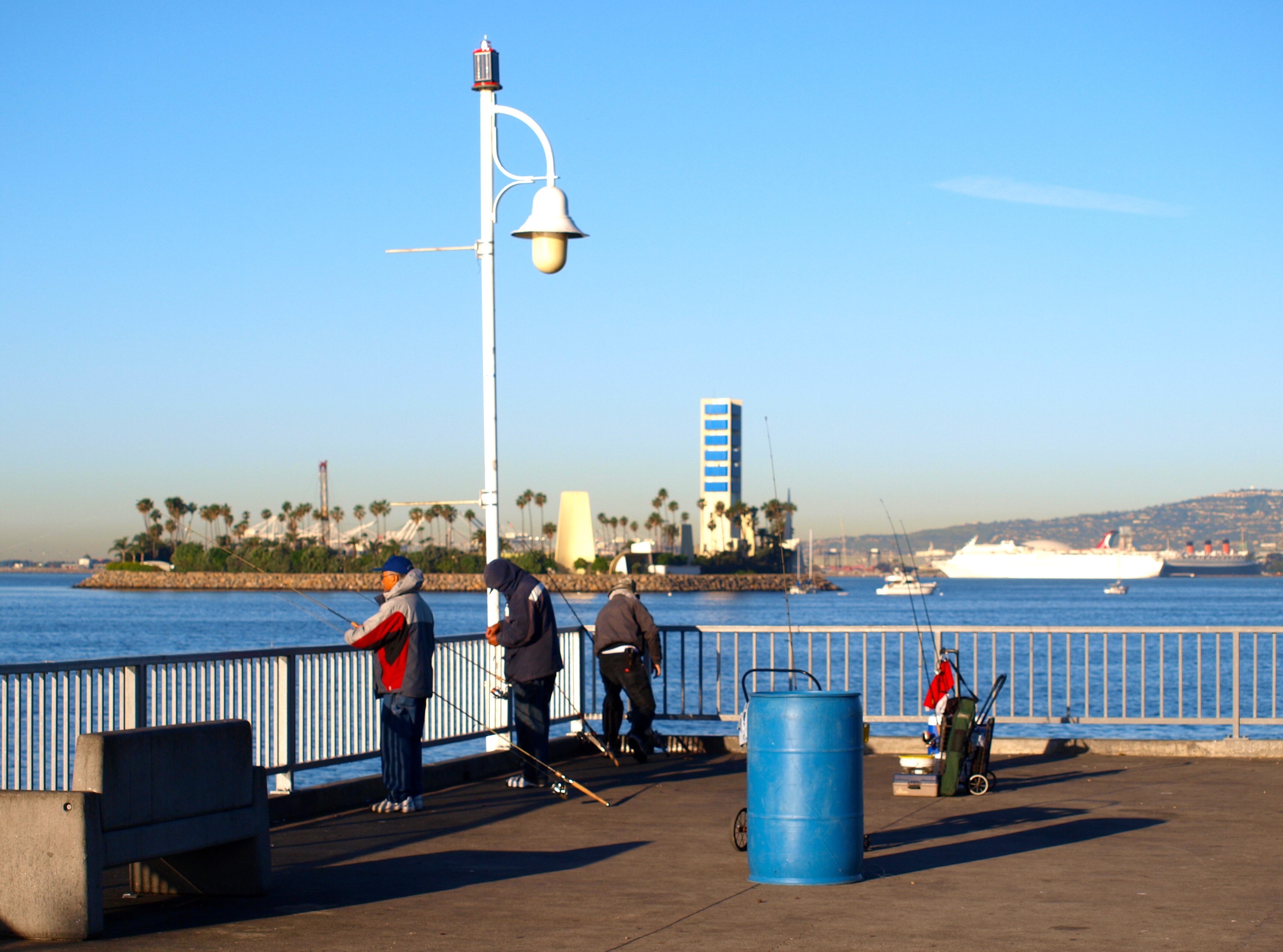
The wide end area itself seems best for the pelagics such as sardines, Pacific mackerel, jack mackerel and bonito (some years). Most of the sharks I’ve seen also seem to come from the end.
Try the inshore, surf area for the larger croakers—spotfins, yellowfins and corbina—with the early morning, and early evening hours (into the dark), generally being considered the prime hours. And though I’m unaware of any stats to back it up, I personally think Belmont may be one of the best piers in the state for corbina (and I have seen as many as thirty corbina caught in just a few hours of early morning angling—by eight anglers) As for bait, corbina especially love sand crabs but fresh mussels, ghost shrimp, and bloodworms can pull in a variety of the croakers. Although anglers will debate the topic of “best rigs to use” endlessly, it generally comes down to a high/low rigging or Carolina-rigging with most of the regulars seemingly using a high/low rig. The next choice is type of hook with some using size 4-2 baitholder hooks (with sand crabs or bloodworms), or size 2-1/0 Kahle hooks (covered with fresh mussels or ghost shrimp). The choice of hook largely depends upon the type of bait you are using and the fish you are seeking.
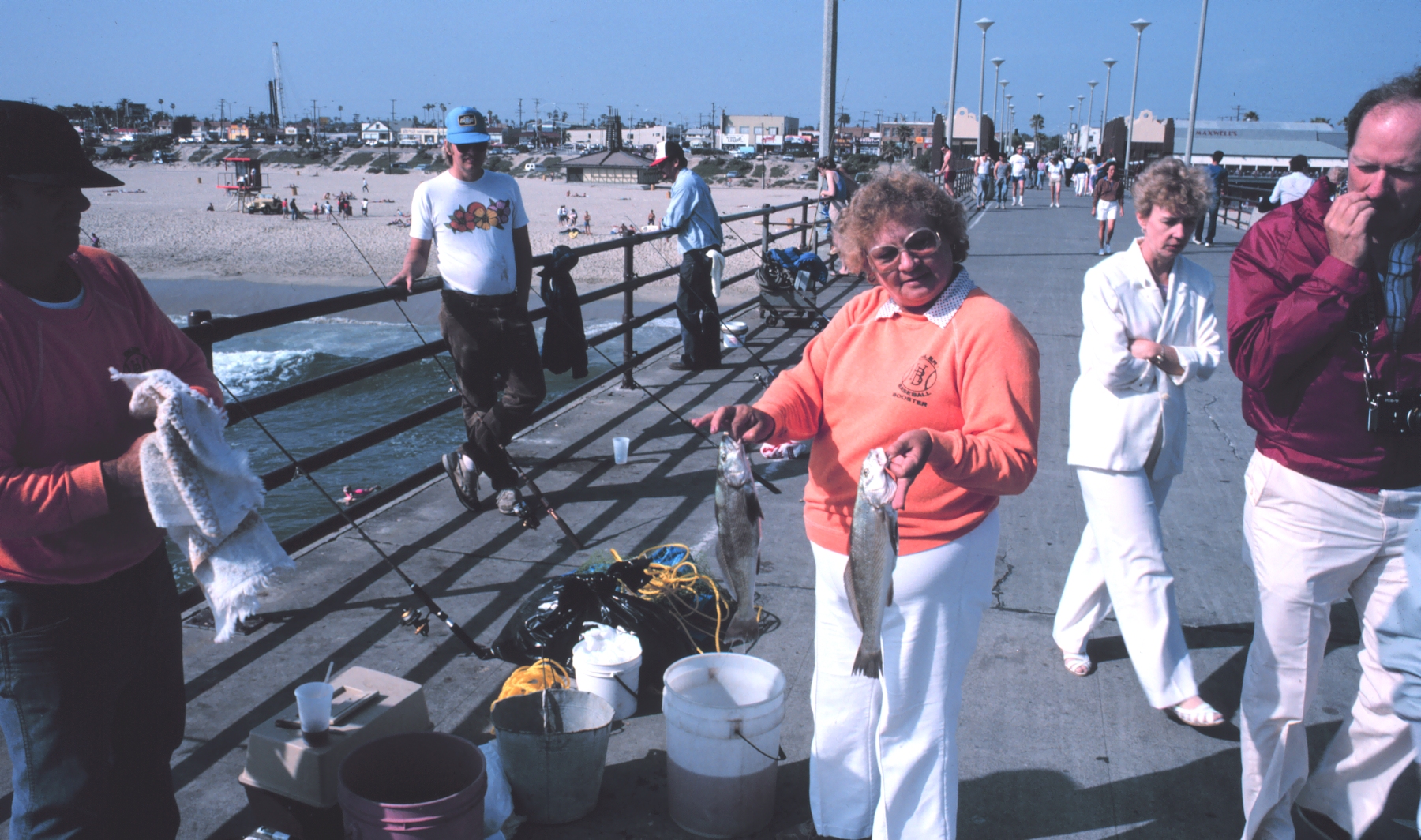
Croakers back in the ’80s
The inshore area out to mid-pier, especially at night will also yield up quite a few round stingrays, thornbacks, and shovelnose sharks (guitarfish) with an occasional smoothhound joining in the fun. Squid, anchovies, and cut mackerel seem best for the sharays. This area can also see “large” fish cruising around under the pier, seemingly at ease with the world, and impervious to whatever baits are thrown their way. They’re often mistaken for white seabass or small yellowtail but in most cases are striped mullet (that can be very hard to catch).
Just to refute the above statement about sardines primarily being caught at the end was a short visit in 2024. Most of my time was spent out at the end trying to lure a fish. Different baits (blood worms, ghost shrimp, anchovies, market shrimp, mussels, and squid), different areas of the pier, and different methods didn’t yield any fish excepting one jacksmelt. I finally decided to try the inshore section hoping a ghost shrimp might yield up a croaker or a corbina. Instead, after going inshore, I found one family fishing the shallows (almost in the surf) and pulling in sardines, 1-4 at a time. I decided to join them and get some fresh bait so I rigged up a Sabiki and started yo yo’ing the rig but with very little success. Here I was supposedly the “guru” of pier fishing and was being totally outclassed by this man and his wife. Finally I asked the husband (and more successful angler) what size hooks he was using on his Sabiki. They were the same small-size hooks.
He then said, “what color are you using and I said white feathers. He walked over, said try this, and handed me a bait rig he had made with green buttons by the gold hooks but with no feathers. I tied on his bait rig and immediately started catching multiple sardines at a time. His name was Fernando and he said he had learned some Sabiki’s don’t work as well as others and developed and now tied his own bait rigs. We had a nice conversation and when it was time for me to leave I handed him a $20 bill which at first he refused to take but I said take your grandson (who was putting fish into a bucket) out for a hamburger. He then gave me one more rig and I felt I had made a new friend at the pier. Fernando’s generosity had made my visit a success. I’ve always said watch the regulars and it paid off once again.
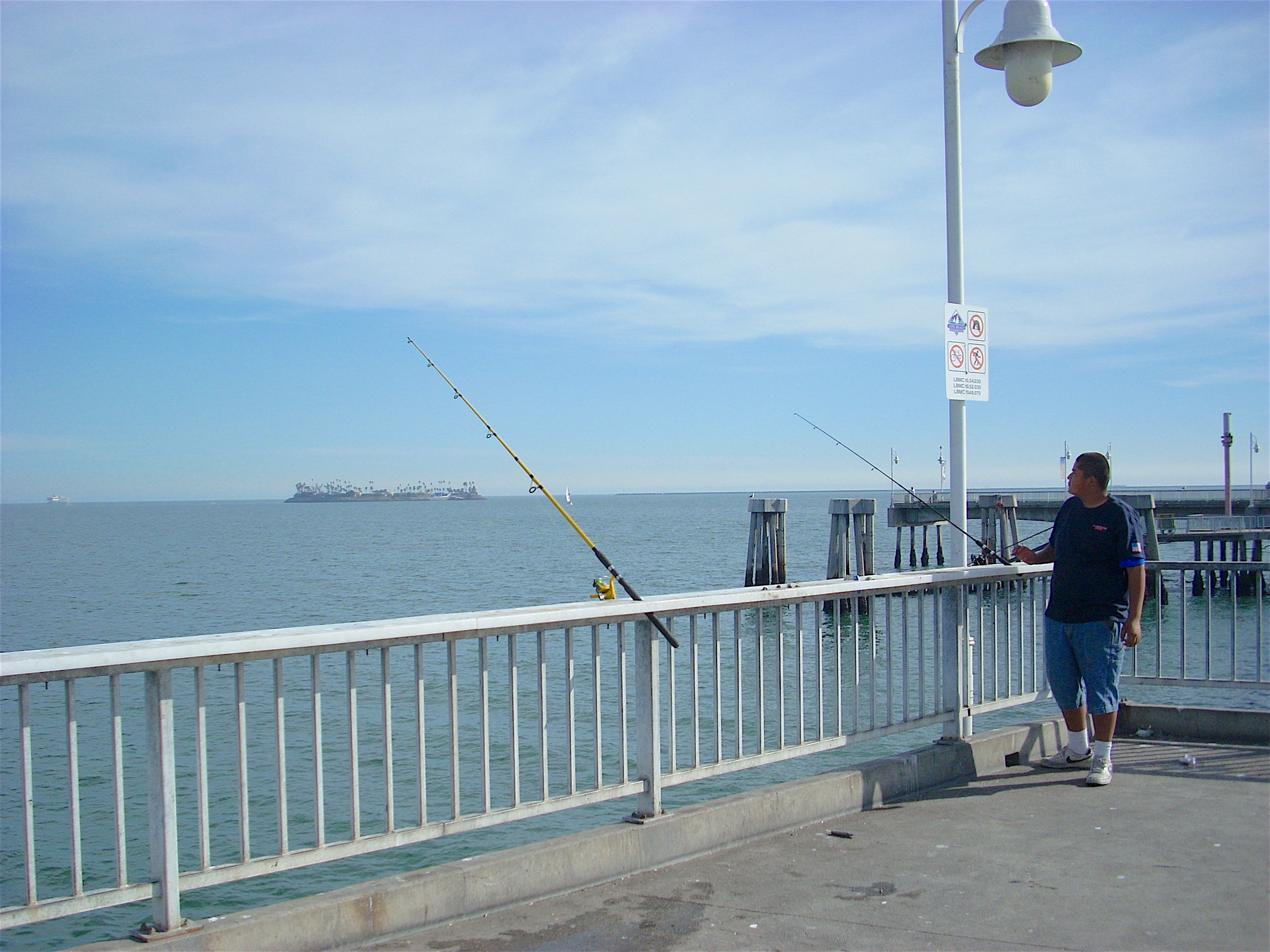
Fish the mid-pier area using a Sabiki/Lucky Lura-type bait rig for jacksmelt, topsmelt, walleye surfperch or queenfish. If you catch a small queenfish, or even a smelt or small mackerel, remember that they make excellent halibut baits. Put the small fish on a live bait leader, sit back, and watch your pole for the light mouthings of the toothy halibut. Pay attention and be ready. The top spot for the halibut seems to be around the black asphalt section near the middle of the pier. Also remember to check the local papers for the times of the grunion runs. Halibut follow the little fish into the shallow waters by the pier.
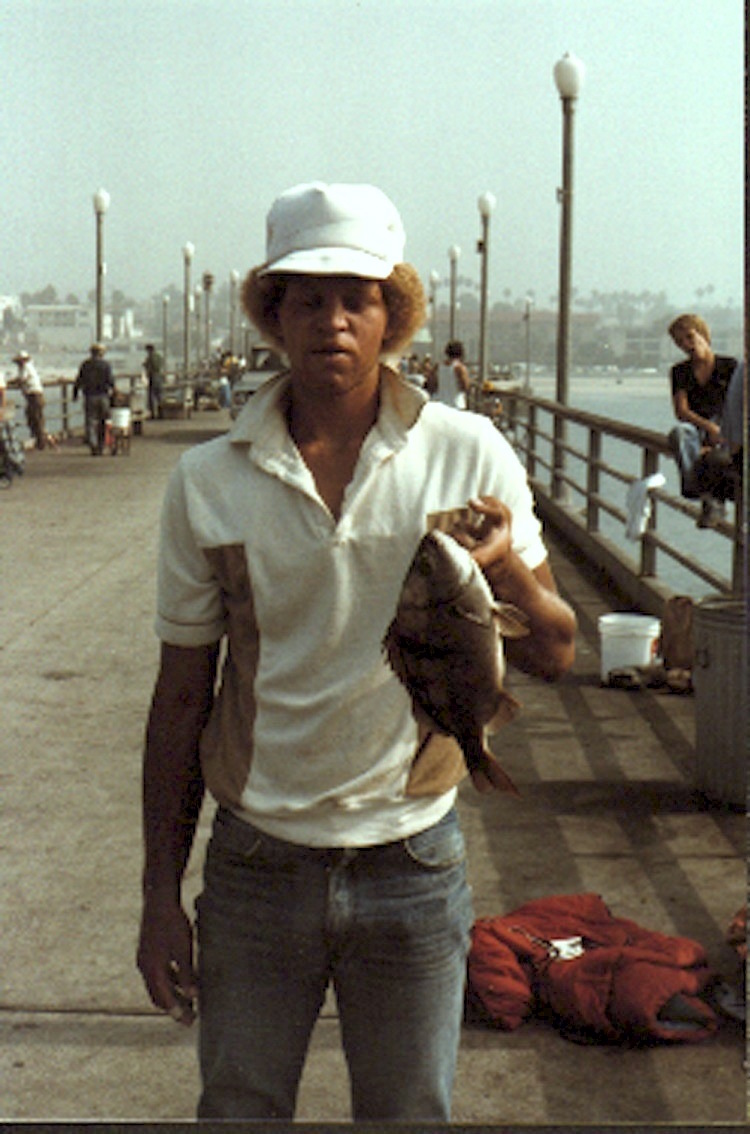
Sargo — 1998
About three quarters of the way out on the pier, on the left side, is a docking area for boats. This, I am told, is one of the best spots for calico bass (kelp bass) and perch, while the end section itself yields up all three varieties of bass—sand bass, spotted sand bass and kelp bass. The far right corner of the end is supposed to be the best spot for sand bass. Most of the bass hit on cut anchovies or squid but some, especially the spotties, will hit on artificial lures with plastics generally the lure of choice.
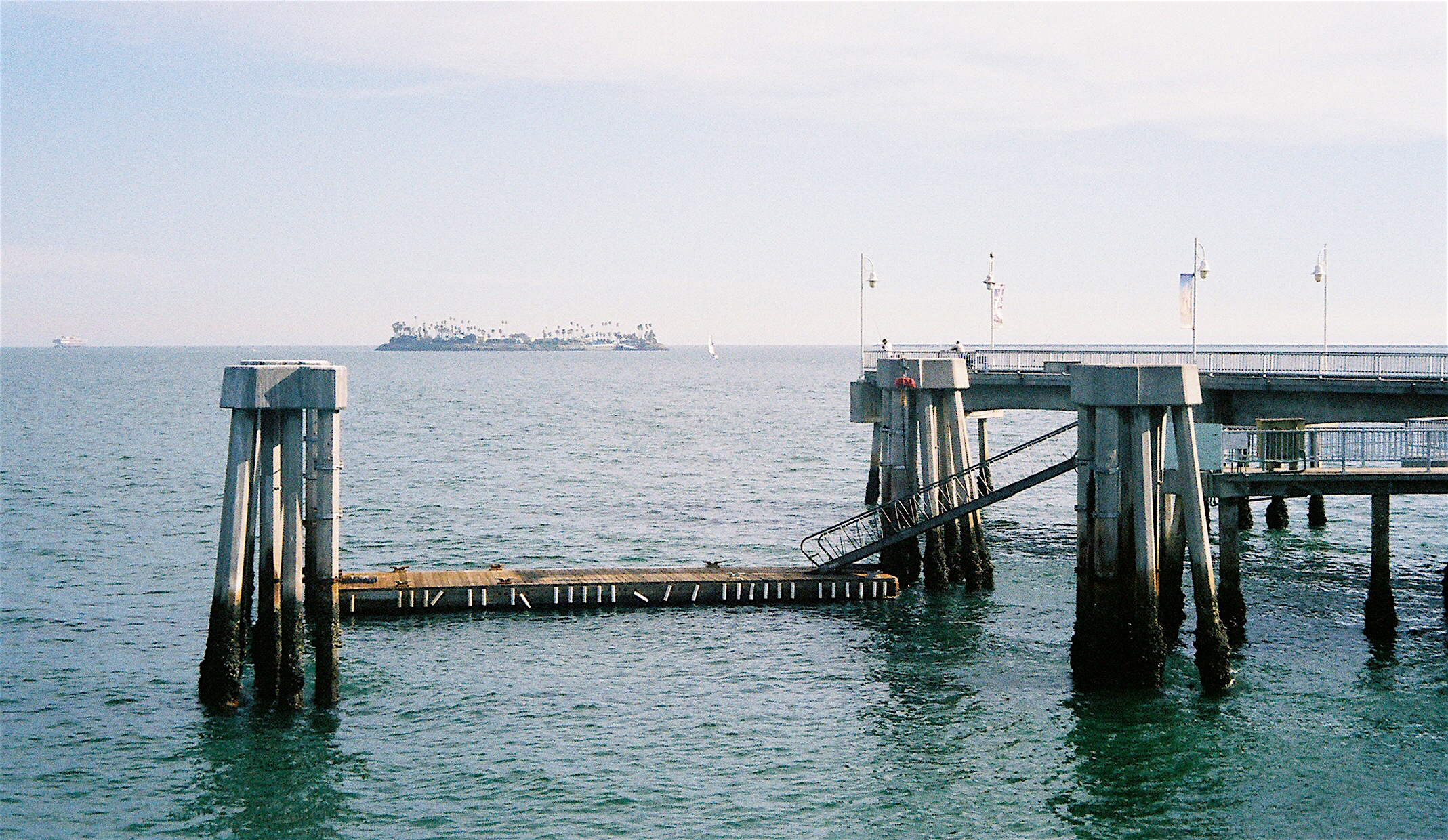
Landing dock — good for bass
Anglers fishing down around the mussel-covered pilings with mussels (surprise) are sometimes rewarded with good-sized buttermouth perch (blackperch), rubberlip perch, or forktails (pileperch). Some years also see good runs of sargo (generally May to July). The scrappy sargo (grunt family) up to about three pounds in weight, love fresh mussels, get positively giddy over live ghost shrimp, and seem to hit best on the bottom near the pilings in the early evening or night hours.
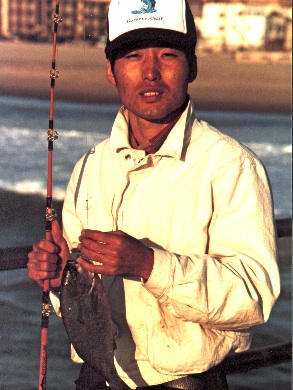
Perch
Fish the outer wings of the pier for pelagics such as Pacific mackerel, jack mackerel, bonito (some years), barracuda and sharks. Use live anchovies when they’re available (generally in the summer months) for the macs, the boneheads and the pencils. Unfortunately, most months see a lack of live anchovies. Plan #2! For the mackerel, fish with strips of squid or pieces of mackerel under a splitshot sinker. Bonito splashers will work for the bonito, as will feathers trailing behind a cast-a-bubble. Spoons, gold colored, when cast at night, may yield a few barracuda during the summer to fall months.
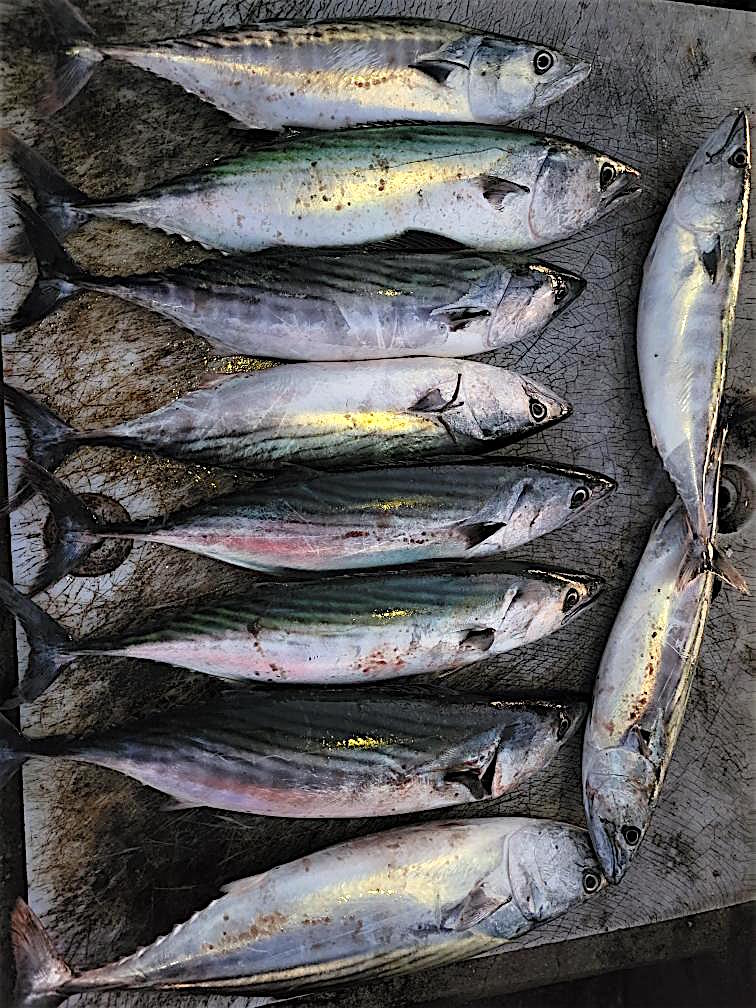
Bonito taken in October 2022
For the larger sharks, jig up some live bait (especially Pacific mackerel or jack mackerel) and then fish them on live bait, sliding leaders. Most of the sharks will be gray sharks (gray smoothhounds), shovelnose sharks (shovelnose guitarfish), leopards (leopard sharks), or pinback sharks (spiny dogfish) but occasionally there will be the larger threshers mixed into the action (a 65-pounder in November 1999, a 70-pounder in September 2001, and a 50-pounder in July of 2002).
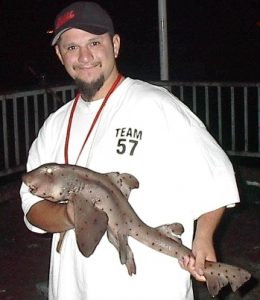
Horn Shark caught in 2005
Less common will be blue sharks and sometimes even a mako shark (aka bonito shark)—a five-foot-long mako being landed in May of ’98. About once every thirty years you’ll also hear of someone latching onto a hammerhead shark and once every so often an intrepid angler may hook a white “man-eater” shark (why do they only eat men?). Interestingly, the number of white sharks seems to be increasing. If you’re satisfied with the smaller sharays, cut mackerel and squid fished on the bottom will yield small smoothies (gray smoothhounds), leopard sharks, thornback rays, bat rays and an occasional skate. If seeking out the monsters, be sure to bring a a net, a strong line, and a couple of strong friends to hoist your prize up to the pier.
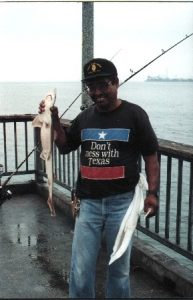
Gray Smoothhound Shark
Some itsy bitsy fish are also found out toward the end. Most common are herring (queenfish), topsmelt, small perch and pompano (Pacific butterfish). All can be caught on Sabiki-type bait rigs jigged at mid-depth range, although the pompano are true Epicureans and prefer to have their hooks sweetened by a delicious but small piece of fresh mussel. I’ve also seen a few salema here but not in the numbers found at other county piers. Lastly, some years will also see small to medium-size lizardfish.
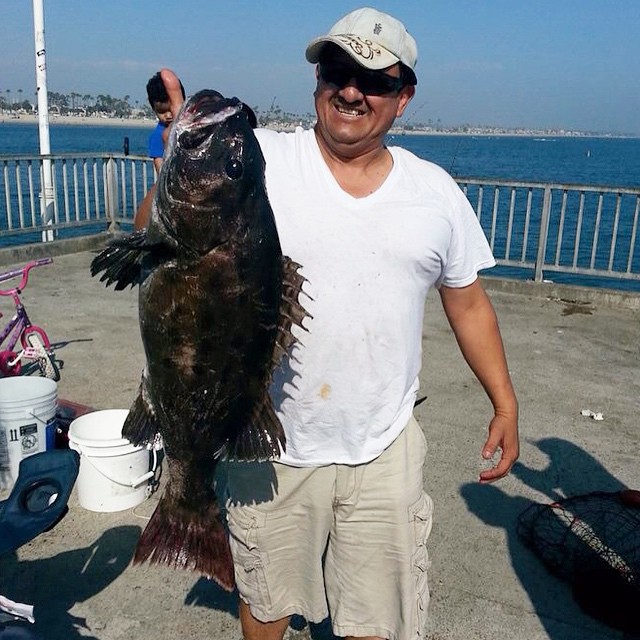
An ILLEGAL Giant (Black) Sea Bass, one that is still somewhat a youngster. If you hook one of these fish net it and bring it to the pier, remove the hook, and then return it by the net back to the water.
Potpourri — Possibly More Than You Want To Know About The Belmont Veterans Memorial Pier
<*}}}}}}}}}>< — Studies done by the Department of Fish and Game between 2004 and 2009 show the pier to have the typical mix of fish for a SoCal sandy-beach pier. Numerically, Pacific sardine led the list followed by white croaker, queenfish, Pacific mackerel, yellowfin croaker, shiner perch, Pacific bonito, topsmelt, walleye surfperch, pileperch, black perch, California corbina, jack mackerel, California halibut, barred sand bass, blacksmith, shovelnose guitarfish, salema, white seaperch, California butterfly ray, spotfin croaker, sargo, California scorpionfish, grass rockfish, rubberlip saeperch, rock wrasse and round stingray. All of these are fish common to the pier and area.
However, due to its size (angling pressure), location, and (perhaps) its proximity to local Fish and Game offices, the pier and adjacent beach areas have also been good ones for recording a variety of uncommon, rare, strange and just plain odd species that have shown up over the years.
One such species is the yellow snake eel (Ophichthus zophochir) whose range is listed from Peru to Berkeley Pier. In July of 1977 a Belmont Pier angler caught a 34 1/2-inch eel. Not only was it an unusual catch, but it was a new record for the species, the previous record being only 32 1/2 inches long. (Yellow snake eels were long considered “rare” in California with less than 20 having been recorded into the ‘70s. However, quite a few have been reported to the PFIC Message Board since 1997. Although most were from SoCal piers, one was caught at the Berkeley Pier.) A second yellow snake eel was reported from Belmont in 2009, a small 13-inch fish that was caught by an angler using squid on a Carolina rigging.
A different type of eel was seen in January of 2010 following a stormy, rainy night at Belmont. PFIC regular Riplee781 reported catching a “weird looking eel fish” that he couldn’t identify. His fishing buddy Jellyfish posted that “it didn’t have a face like a eel. It had a face like a white croaker and the skin was like a white croaker, scaly and sliver in color.” It sounded like a cusk-eel to me and after posting a picture of a basketweave cusk-eel to the site, they confirmed that it was the fish that had been caught. A still unidentified eel was a 4-foot-long specimen reported to the PFIC board in September 2008, a fish taken on anchovies near the surf line.
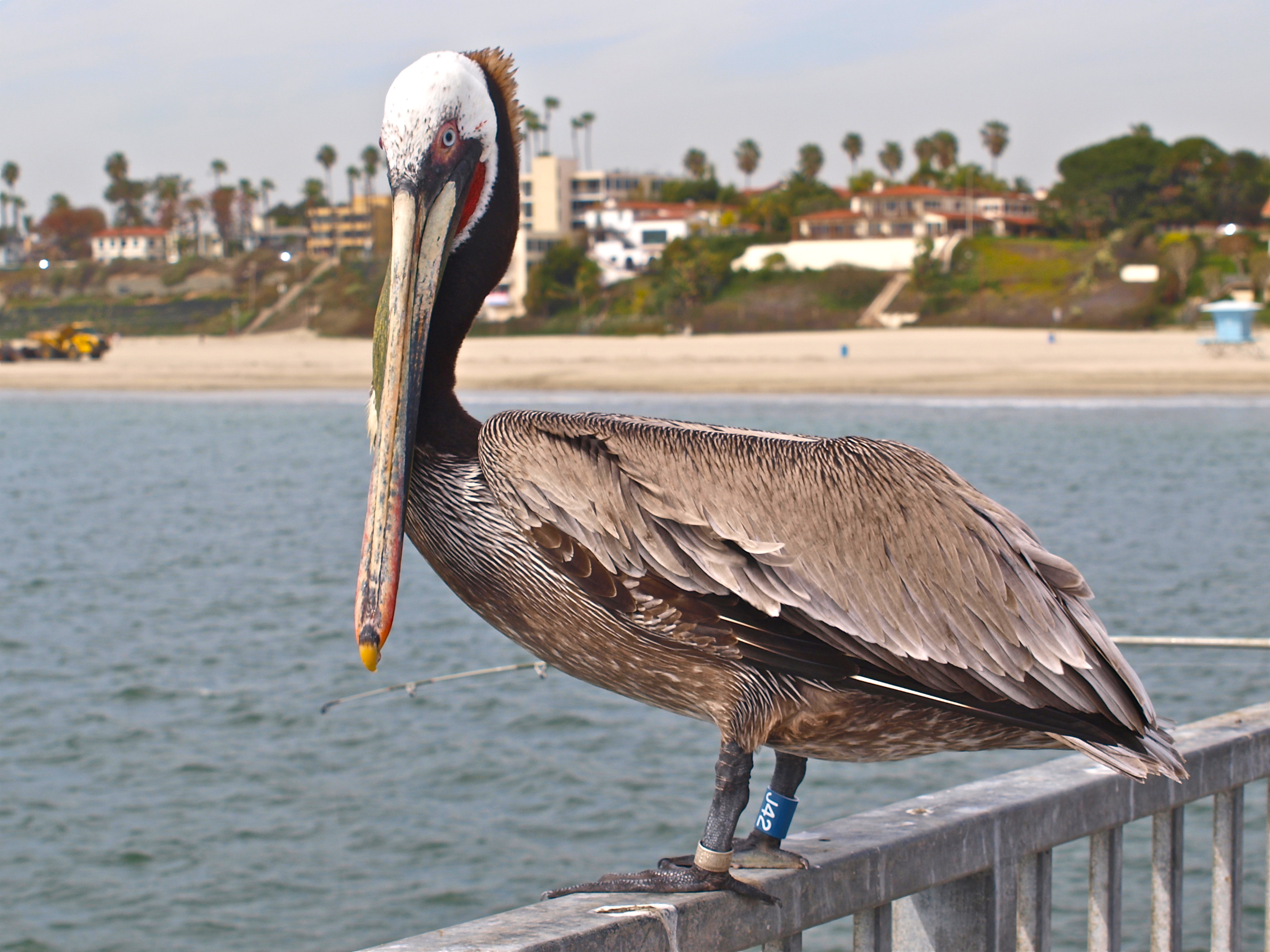
Sturgeon in Long Beach? Although far from being the largest of their species, two far-from-home green sturgeon were taken at the pier many years ago. As reported by Fitch and Lavenberg in 1971, one sturgeon was 36 inches long and weighed 6.5 pounds while the other was 35 inches long and weighed 5.25 pounds. Since green sturgeon can reach at least 350 pounds in weight, these must have been mere juveniles out exploring the world.
On May 29, 1958 a Pacific thread herring (Opisthomema libertate) was caught from the pier and since no one seemed to know what it was the F&G was called in for identification. A green jack (Caranx caballus) was recorded on November 24, 1957 from Belmont Shore but it isn’t noted if the fish was caught on the pier itself. The ’57 and ’58 catches were during a time of El Niño conditions. Two bonefish were taken early summer 1963.
El Niño undoubtedly also played a part in the catches of unusual fish just a decade ago. A number of threadfin shad (Dorosoma petenense) were landed in October 1997. These fish are common to Central America but considered rare in our ocean waters (although they have been reported from the Long Beach Harbor in the past). In addition, deepbody thread herring (Opistlzonemu libertute) were also reported and examined during the same fall month.
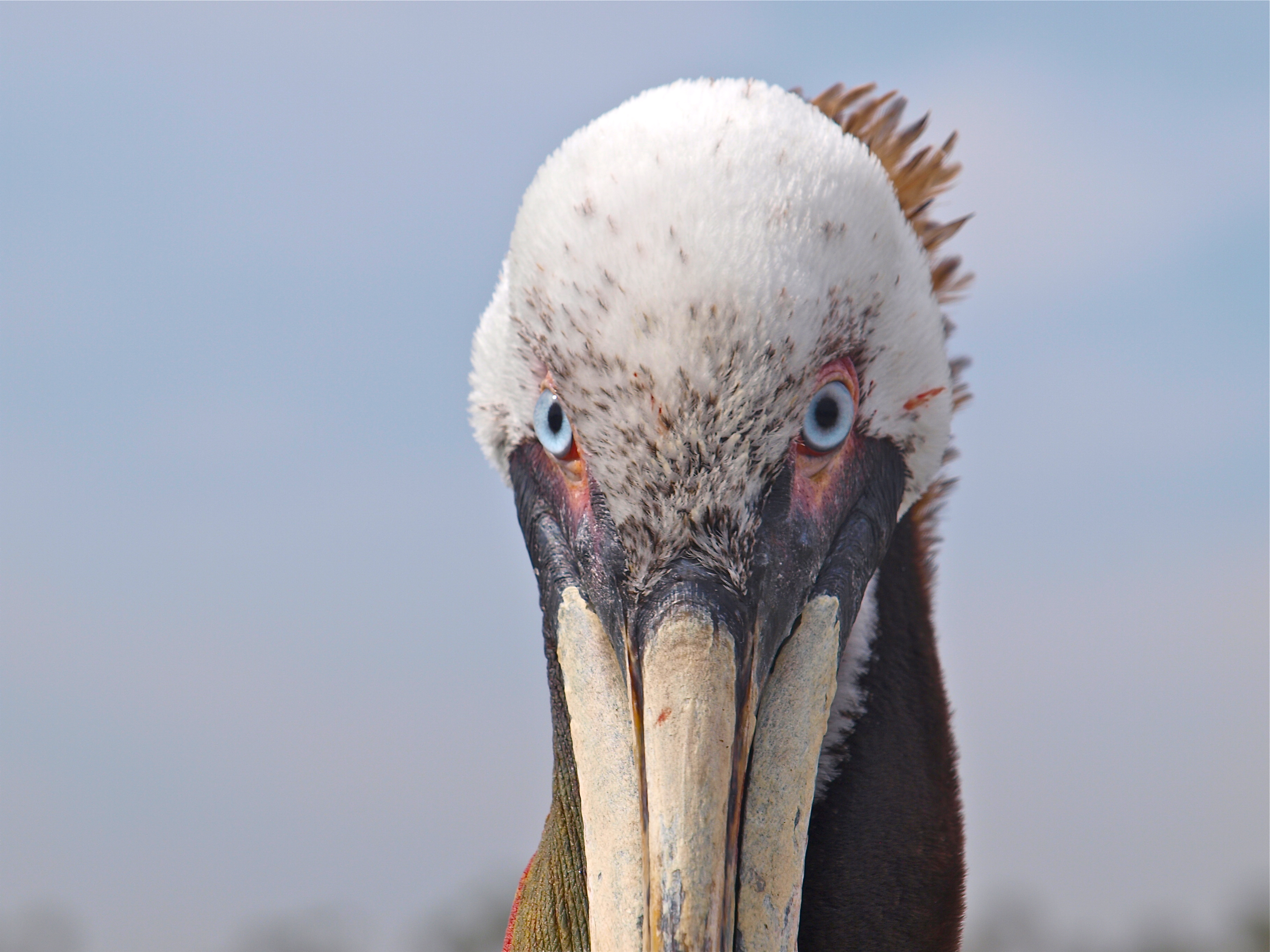
A species reported by marine biologist Milton Love is the normally-found-in-freshwater tilipia. He reported that several have been taken from the pier; they apparently are able to live for some time in high salinity waters including saltwater.
In addition to these pier-caught fish are a number of fish that that were taken in the surf near the pier. One of the rarest was a Pacific bigscale pomfret (Taractichthys steindachneri), one of only a handful recorded from the eastern Pacific. As reported by Fitch and Lavenberg in 1968, the fish “was caught barehanded on March 17, 1964, in the surf near the Belmont Shore pier by a Long Beach fisherman, Kevin Desmond. This fish was 678 mm TL, and weighed about 5.5 kg (12 lbs).”
Going even further back in the record books, the first escolar (Lepidocybium flavobrunneum) from California was picked up on shore at Long Beach in the spring of 1928. This fish, 734 mm TL, was recorded by Myers in 1932 as Xenogramma carinatum, and apparently represented only the fifth or sixth known specimen from anywhere in the world at the time. The second specimen from California was 610 mm TL and weighed 1835 g. It was picked up in the surf near Marineland of the Pacific’s pier on August 1, 1960 (California Fish and Game, April 1978).
An oddity, although not a rare species, was a fish captured by hand in March of 1998. It seems a Belmont Pier angler spotted a fish that had beached itself on the sand while chasing a school of grunion into the shallow waters. The angler raced down to the beach and grabbed the fish. Turned out to be a 7-pound skipjack tuna (Euthynnus pelamis)! What the normally offshore fish was doing in these inshore waters is anyone’s guess.
Lastly was the strange fish reported by Vernona Fath (Snookie), our Balboa reporter. The fish was one of the mainstays of California pier fishermen, but one with a freaky, oddball twist. In response to a PFIC Message Board thread concerning halibut that were brown on both sides, or white on both sides, she reported: “Yes, I have seen some of these halibut with unusual color patterns. Some have been solid. Others have been patchy. In 1955 there was an albino halibut caught off Belmont Pier. It was almost completely white with the exception of black fins, a black tail and black eyes. Fish apparently don’t have pink eyes as in other albinism cases. This fish was 13 3/4 inches long and weighed less than a pound. It was a healthy specimen. It was also the first halibut with albinism to be caught and seen.” So yes, this pier does yield some unusual critters.
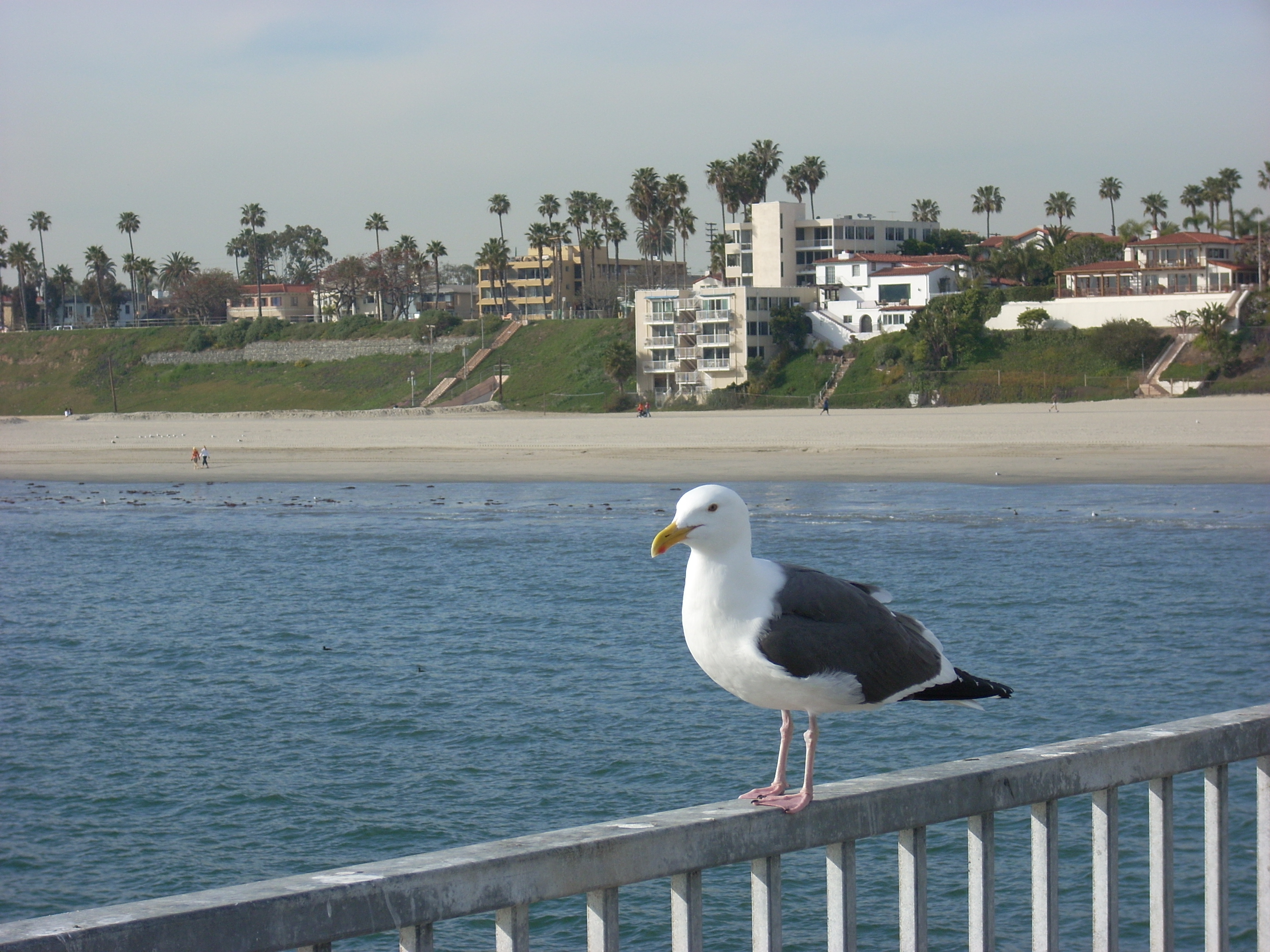
A final fish was the catch of a catalufa in 1975 (see story below).
Rare fish caught at Belmont Pier
Casting a bait and then sitting down and watching the rod tip on Belmont Pier isn’t the most glamorous and exotic fishing along the Pacific Coast, but it’s restful and sometimes productive for perch, an occasional halibut and other species. Then too, you meet interesting people.
Gerald Osier of 221 Grand Ave., who has worked on the pier and still does some parttime work there in the summer months, likes to fish the pier and just loaf. Just recently he caught one of the rarest fishes in the Pacific Ocean. It was small, and there was no way that he could have filleted it and got a dinner for two. So he reported to the department of Fish and Game, and one of the DFG biologists came to take a look and carry the fish back to the laboratories at 350 Golden Shore. The fish was red, looked like a perch, had large blue eyes almost the size of nickels, weighed 11 ounces, and was 9 ½ inches long.
Now Osier has a letter from John Fitch, research director of the State Fisheries Laboratories at Long Beach DFG, saying that the fish is a catalufa, extremely rare. In fact, said Fitch, fewer than 15 had ever been caught either by hook and line or in commercial nets in all the time that he has been with the DFG.
Fitch, in his letter to Osier, said that the largest catalufa that he had ever seen was 13 inches long and weighed two pounds. He also told Osier that the fish was being sent to the Natural History Museum in Los Angeles. It will be made into a mount and displayed.
This is just one sample of what can happen in pier fishing, which can be fun for individuals or a family except for the fact that all piers now are afflicted with vandalism. What public facilities are not endangered the same way? Belmont Pier is the one remaining public fishing facility in Long Beach and it deserves enough security protection to keep it clean.
Frank Hale’s Seal Beach Pier is another facility that is so close to Long Beach that it really gets more trade from this city than from Orange County. One of the reasons is that Hale has a barge— the only barge in this area— anchored in an area that is virtually in the San Gabriel River channel, where bonito and mackerel like to swim and hunt food.
—Donnell Culpepper, Long Beach Press-Telegram, November 21, 1975
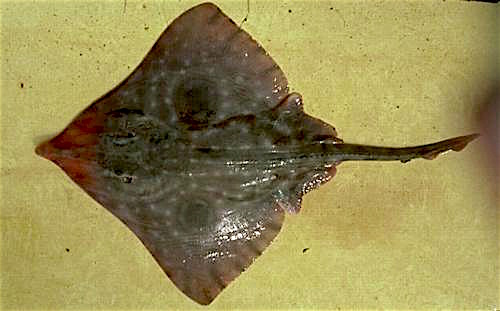
A not so big big skate
<*}}}}}}}}}>< — An interesting story comes from George Van Zant, a writer for Saltwater Sportsman Magazine who calls himself “Piscatorial Prevaricator II.” He has a web site called George’s Corner and one tidbit caught my eye: “Most of my elementary school years [’40s?] was spent on Belmont Pier where I raised money catching herring for the halibut fishermen. 5 cents each was the charge unless I swam the bait out, then it was 25 cents. I learned to swim in the Colorado Lagoon and more importantly I learned to catch smelt with a bent pin. I used them to catch 100 pound “rat-tail” sting rays off the lagoon floats.” Sounds like catching herring (queenfish) and smelt for live bait has been a standard technique for quite some time.
<*}}}}}}}}}>< — The pier played the part of another pier (the Balboa Pier) in episode 13 of the television series The O.C. Usually the Redondo Beach Pier played that part but it’s speculated that Belmont’s shape was preferred for a scene where two of the characters—Sandy and Rebecca—scattered the ashes of Max. It sounds just a tad complicated to me and I never even knew Max.
<*}}}}}}}}}>< — The barge Annie B was accessible from the Belmont Pier for many years. It was where I spent one so-so night in 1988 with a group of marine biology students from Anderson Valley High School. We had traveled down the 500+ miles from Boonville in vans and planned to spend the entire night on the barge in part to save the cost of a motel.
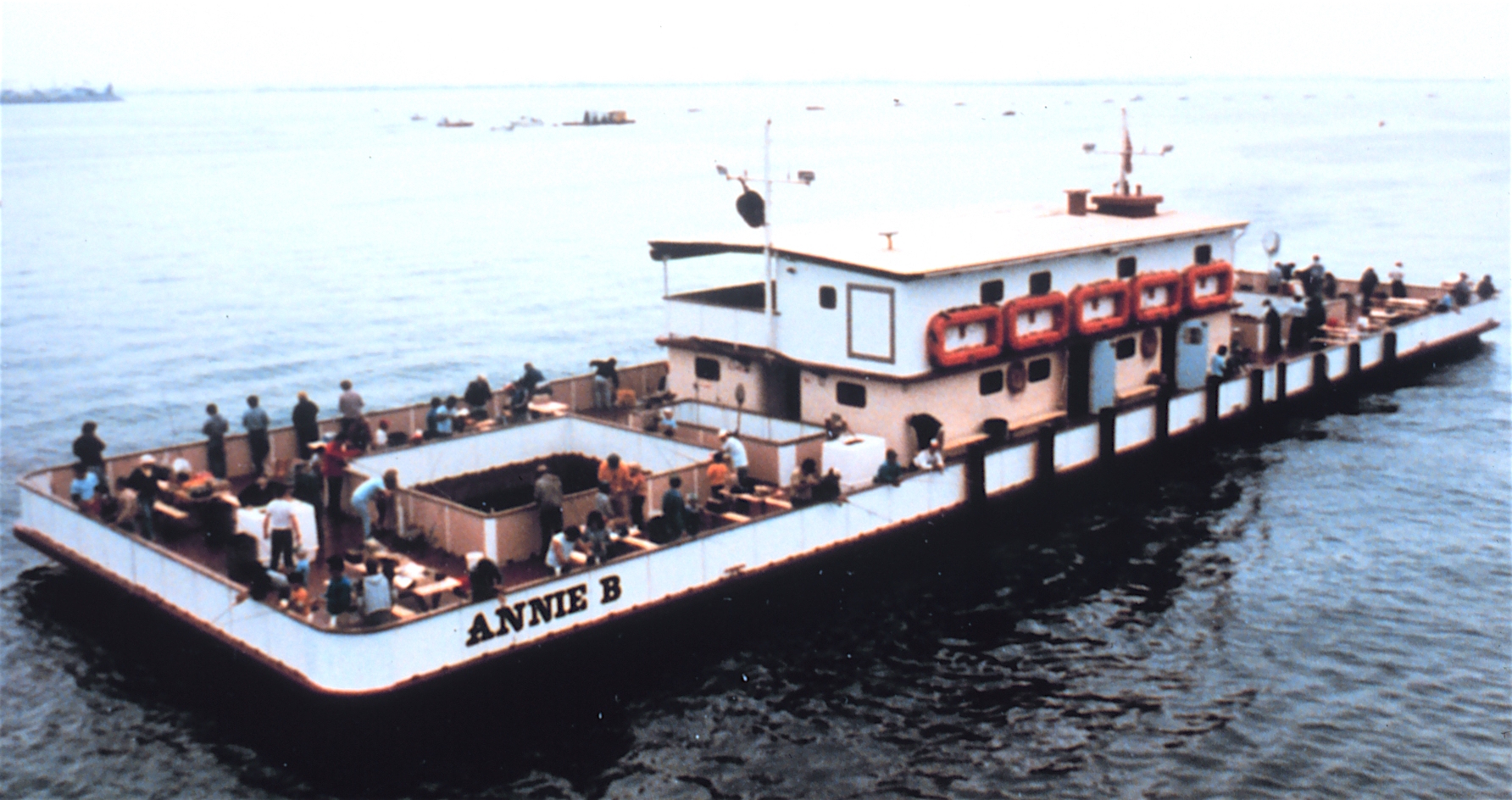
Unfortunately, the catch was mostly queenfish and white croakers with a few mackerel mixed in for variety. Not exactly big game and I grew tired of answering the question—“Mr. Jones, when are we gong to catch some big fish?” Luckily most of the students were asleep by 3 AM while I continued to fish. It probably wasn’t the smartest decision since I had to drive a van to San Diego the next morning.
In San Diego we made sure to stay at the Crystal Pier where we were able to do some fishing in between back-of-the aquarium tours at Sea World and the Birch Aquarium at Scripps. We did seek out the bigger fish (yellowtail) on the Mascot VI out of H&M Sportfishing but unfortunately most of the students were seasick for much of the trip. Once again, that’s why it’s called fishing not catching.
<*}}}}}}}}}>< — I think this rates as one of my top ten favorite pier articles:
Eye Opener—Belmont Pier Marlin Club
Thursday wasn’t exactly a good day to have lunch with the Belmont Pier Marlin Club, but it was the best offer I had. I mean 1 don’t want to be a prophet of gloom and doom and I’m not going to mention that nasty word that ends in “cession,” but don’t you think luncheon invitations are getting scarcer?
It was a bad day for the Belmont Pier Marlin Club because the wind was blowing, which is bad for fishing, but, anyway, I made my way to the pier and found Pop Shoat, the club’s executive vice president, leaning over the railing and gazing placidly at the spot where his line slanted into the blue water.
“Hiya, son.” he said, waggling his white beard-stubble in greeting. He unwrapped a piece of newspaper from around a package of sandwiches. “Have a sandwich. That’s your column they’re wrapped in.” “Gee, thanks.” I said, overwhelmed by this expression of esteem. “I read Hollingworth. too,” he explained, “but I save him to wrap the fish I catch.”
“It’s fresher material.” I agreed. There is not an ounce of professional jealousy in me. “Do they pay Hollingworth, or is that just a hobby?” “Dr. Honk Hollingworth.” 1 said, “is on the payroll as director of our department of vicarious physical education.”
A three-wheel electric auto came dashing down the pier blandly ignoring the sign that said, “No motor vehicles beyond this point.” There were more vehicles beyond that point than on the legal side of it. Some Long Beach electric auto salesman has been making a killing by telling his customers they are driven by rubber bands, maybe.
“What I wanted to talk to you about,” Pop said as he rebaited his hook, “is getting the city to put up a flagpole on the pier for the Marlin Club. Stand back while I cast.” He gracefully snapped an overhand cast that carried his hook far out from the pier and watched his sinker splash into the water. I watched the sign that said. “No overhead casting.”
“I’m no lobbyist.” I said. “Besides, why does the Belmont Pier Marlin Club need a flagpole?” “To fly a marlin flag, in case somebody catches a marlin.” “I have checked this out with Riley Compton of the Belmont Bait & Tackle,” I said. “You catch mostly small fish—perch, herring, corbina. Now and then you get a 10 or 12 pound halibut. Last year, a big white sea bass was landed. But in the history of living man, no one has caught a marlin off Belmont Pier.”
Pop pulled a flask from his gear box. “How about a snort?” he said. I glanced disapprovingly at him and then at the sign that said, “Consumption of alcoholic beverages not permitted on pier.” “Geritol,” he said. “Somebody might catch a marlin. And it would bring an awful lot of fishermen to Long Beach if there was a marlin flagpole here and they thought we needed it.
“Mere tourists,” I said. “The dropline trade. They’d crowd the regulars away from the railing.” “That’s happening now,” Pop said. “The truant officers ought to tighten up on kids playing hookey. Us retired gaffers can’t elbow on even terms against those kids.”
He reached for the Geritol and kicked over the carton of ghost shrimp that was the bait of the teenager next to him. “Sorry,” he said. The teenager gave him a hurt look, “That’s the third time you’ve done that,” the boy said. He picked up his gear and moved down the pier. Pop chuckled gleefully. “Whippersnapper,” he said
—Bob Wells, Long Beach Independent, February 3, 1962
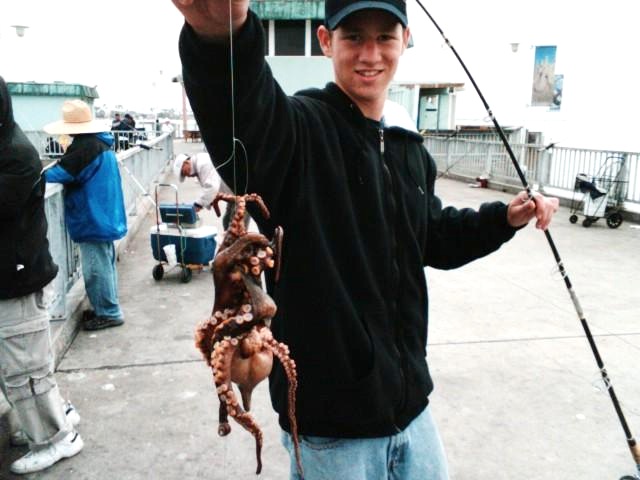
A gnarly little octopus
<*}}}}}}}}}>< — Halibut are one the favorite fish for SoCal anglers and though the pier is generally a fair to good producer of the flatties, few days match the following:
Belmont Halibut in Fantastic Run
Halibut were flopping on Belmont Pier Thursday and Friday almost as fast as fishermen could bait hooks with live anchovies and cast out practically in the breaker line. All of the fish were being caught in extremely shallow water.
More than 100 halibut were caught within three or four hours Wednesday afternoon and the pace was keeping up Thursday morning. Most of the flatties were in the small class, one or two pounds, but there were some larger. For instance, Al Koerner had one that weighed 11 pounds, 4 ounces. Wayne Harris had a 5-13 fish and Paul Kardell had one that tipped the scales at 5-10 ½.
There were losses, too, as fishermen tried to wind up the fish and toss them on the pier. Hooks came out of monofilament knots, lines broke and other fish just fell off when the hooks came out of their mouths. Along with the halibut came a run of small bonito and occasionally a barracuda.
Belmont Pier’s smiling woman manager, June Ascoles, and her helpers were kept busy scooping live anchovies out of the tank for the customers, who stood almost shoulder to shoulder at times along the pier near the land end.
Sportfishing boats and private craft got into the act when it was learned that the fish were so close to shore. The G. W., out of Seal Beach Pier, has been harvesting a beautiful catch of halibut every day just outside the Long Beach breaker line.
—Donnell Culpepper, Long Beach Press-Telegram, May 24, 1968
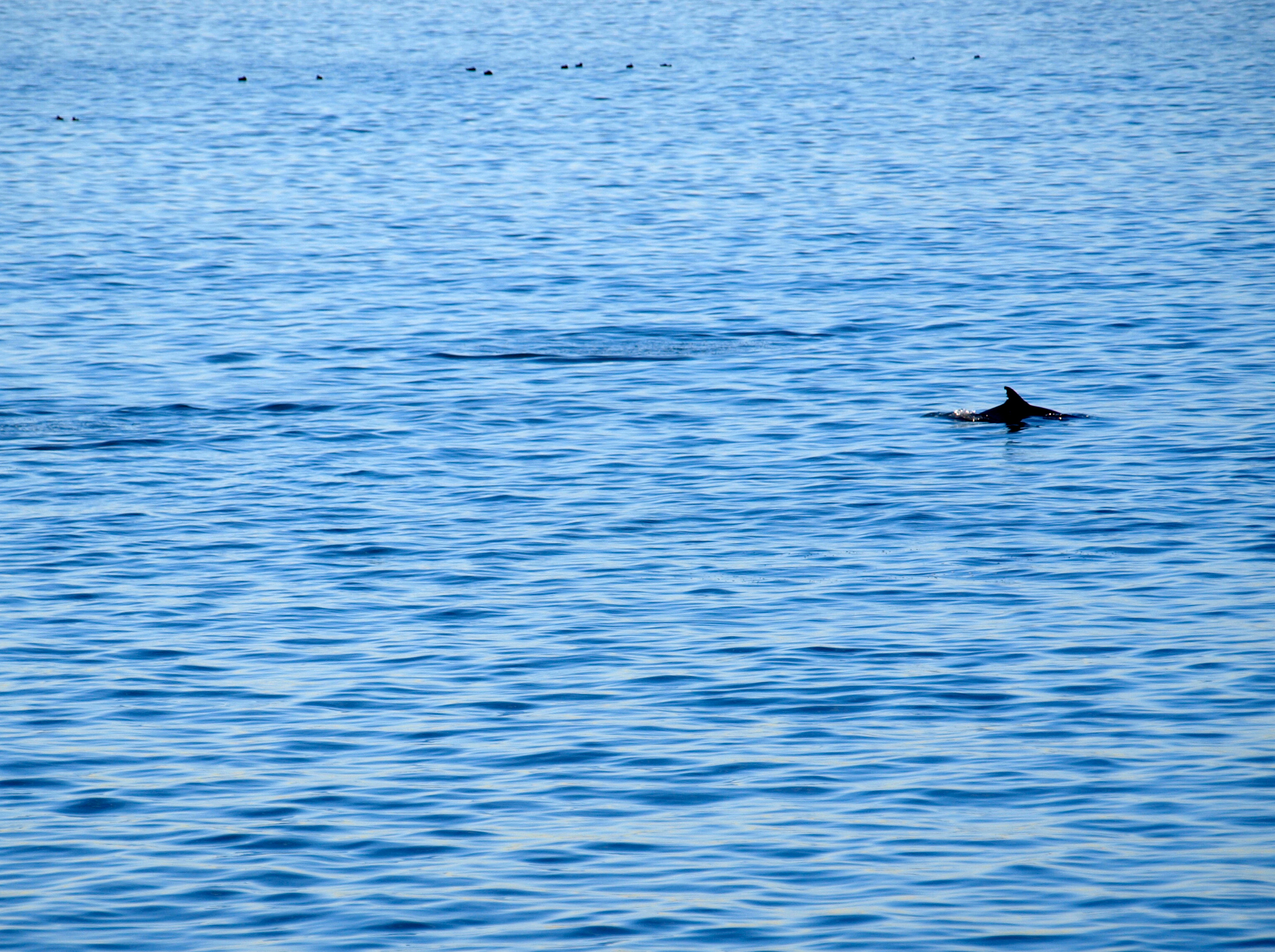
Dolphins are a common companion
<*}}}}}}}}}>< — Although halibut are one of the most sought after fish from piers, yellowtail rate as something special—and their catch from any pier is rare.
Halibut Boy Anglers Make Unusual Kill — Youths Take Yellowtail in Belmont Pier Battle
Two Jordan High School boys, an anchovy and a 17-pound yellowtail made local fishing history at Belmont Pier at an early hour yesterday morning.
Eugene Twombley, 16, of 5859 Gardenia Ave., and Tommy D’Amico, 15, of 1701 E. 60th St., started fishing at the pier Friday night about 7 o’clock. Eugene said they fished by the shelter house for a while and then all along the pier.
They rested at times but kept at it all night. They snagged several jack smelt, five sand sharks, one shovelnose shark and scads of herring and tomcod.
But, it was along about daybreak that Eugene baited up with the anchovy and made a mighty cast out into the ocean from the end of the pier.
“Wham!” Out went a hundred feet of line. The fight was on. Tommy said Eugene battled a while and then he took a turn. The yellowtail went to the bottom, it darted one direction and then another but gradually the boys worked it into the pier where a lone spectator stood ready with a net to help the lads.
Eugene was at the reel when the fish neared the pier. It darted under the pier and the boys just had enough strength left to pull the fish back from under the pier long enough for the stranger to lower the net and bring up the prize.
Mel Mclntyre, veteran fish tackle man at the pier, says there had not been a yellowtail caught at the pier for several years and that he doesn’t remember one that large ever having been caught there before.
—Long Beach Press-Telegram, June 13, 1948
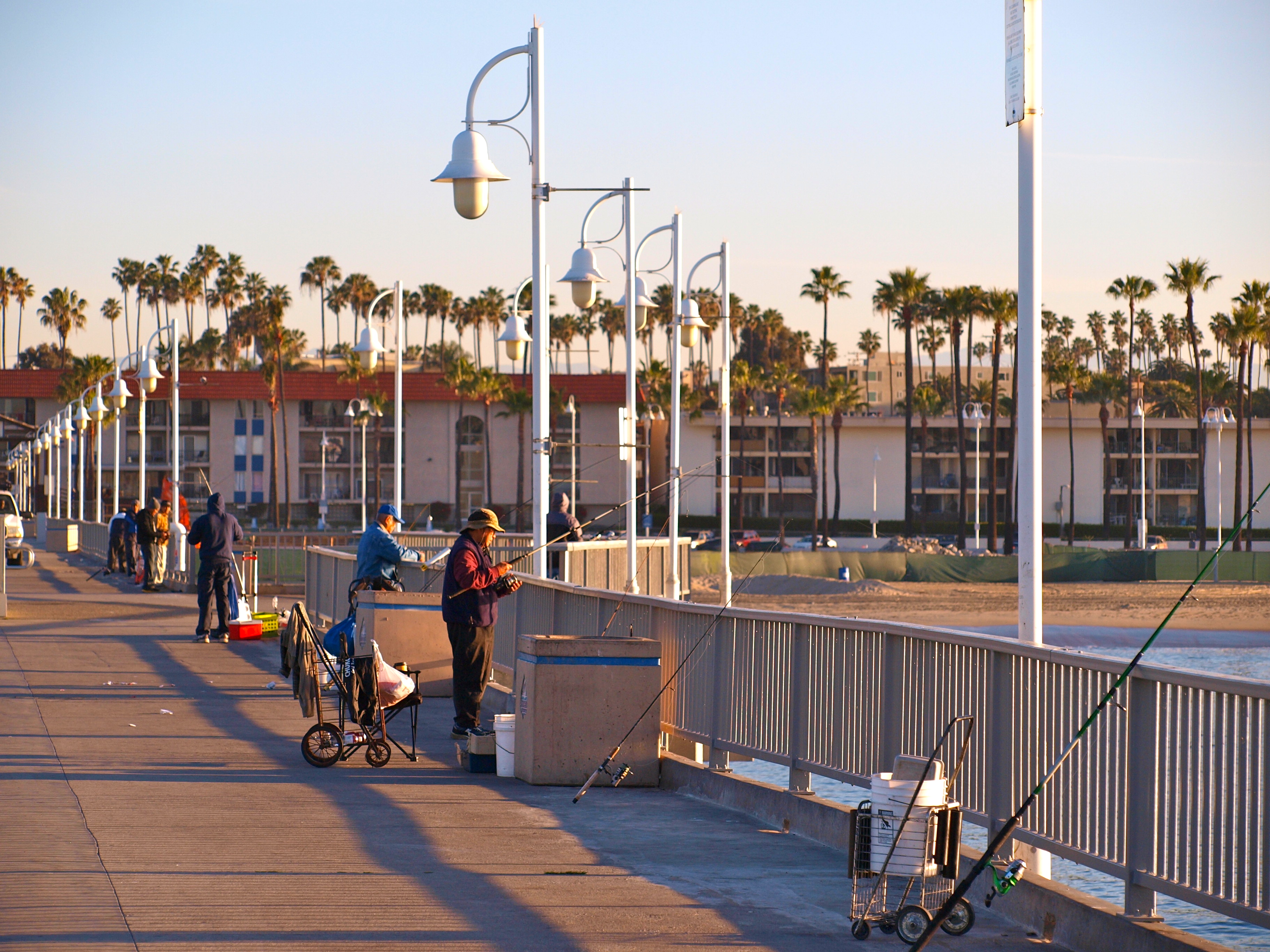
<*}}}}}}}}}>< — Some reports have too much information, some reports too little. In my humble opinion this story falls into the latter category.
A BATTLE with a monster jewfish off Belmont Pier occupied Lester Bobb, jeweler, for more than an hour. The fish, which weighed 415 pounds, was caught with a cane rod, reel and silk-linen line
—Long Beach Press-Telegram, June 15, 1929
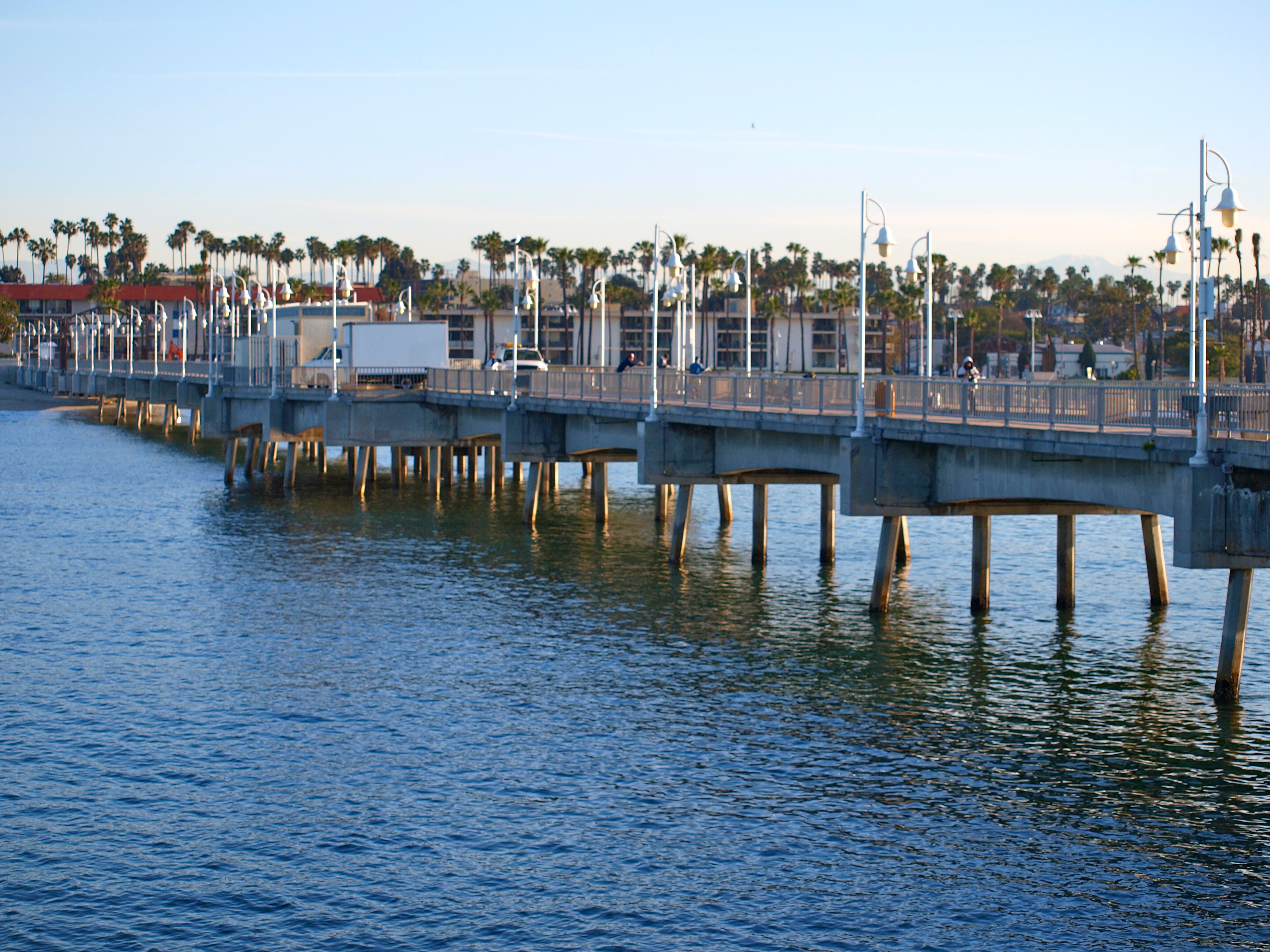
<*}}}}}}}}}>< — Bonito are one of the hardest fighting pier fish and a favorite on many pier rats. And sometimes they show up at the pier…
Bonito Greatest News for Piers
Schools are out and there is something worthwhile to cheer about in the fishing world: Pier fishing has never been better as a starter for the kids’ summer. Belmont Pier, the only one which Long Beach can claim for its own, has had a run of bonito that is nothing short of fantastic.
I got mixed into the Belmont Pier run this week while visiting Art and June Ascolesi, holders of the master lease on the pier. Business was so brisk at the bait and tackle shop that I found myself helping sell jigs, bait, tickets, etc., for a few minutes while June worked the bait tank and Art took care of some mechanical problem in the pumping system.
The pay? Just the joy of seeing happy fishermen running around from one spot to another, tossing jigs and live bait. Some caught bonito every few minutes while others, as always, found the going slow, simply because they did not have the right outfits and the knack of knowing what to do.
One angler, certainly a neophyte at most any kind of fishing, returned to the stand for his seventh jig; he said that he already had lost six. The answer was simple: He was not using the right kind of a knot to tie his monofilament to the hook.
Monofilament is a strange material and one of the first things you should do when using it is to get a booklet, available at most sporting goods stores, that shows how to tie knots. Such pictures usually included with packaged monofilament.
The bonito run is occurring elsewhere too, with offshore fishing boats loading up with larger fish than those being caught on the piers. Mrs. Geraldine Poitz, of Seal Beach Sportfishing Pier, also reported that the run was continuing at that pier and on the barge. Belmont Pier’s barge had similar reports.
Parents of youngsters who like the outdoors should be especially happy about pier fishing this year. There is absolutely nothing like a few flopping fish on the deck of a pier or of a barge to encourage more and more young fishermen to get into the act.
However, there is one factor in this month’s fishing that disturbs me, and it’s likely to annoy the Department of Fish and Game to the point of clamping down on anglers who are catching and sacking up dozens of pencil-size barracuda.
And when I say “pencil-size,” I mean just that. The fish are plentiful around the piers, along with the legal size bonito, but if the fish are not fatally hooked, they should be returned to the ocean.
There is a definite size limit on barracuda and I don’t care whether they are caught by anglers 5 years old or 95 years old, two undersized barracuda comprise the only small ones that can be taken in a full limit of 10 fish of that species.
—Donnell Culpepper, Long Beach Independent, June 21, 1968
Special Recommendation. Because of elevated levels of DDT and PCB, the Cal OEHHA recommends that no more than one meal of locally caught surfperch be consumed every two weeks.
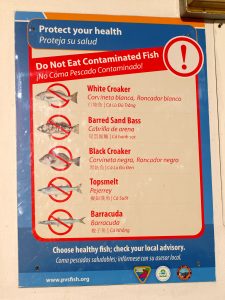
History Note. Belmont Pier was built in 1968 alongside the older Grand Avenue Pier, a pier that was also called the Belmont Heights Pier by some, and the Devil’s Gate Pier by others (in reference to the geologic formation—a natural bridge, which in those days extended seaward from the low bluffs at 39th Place).
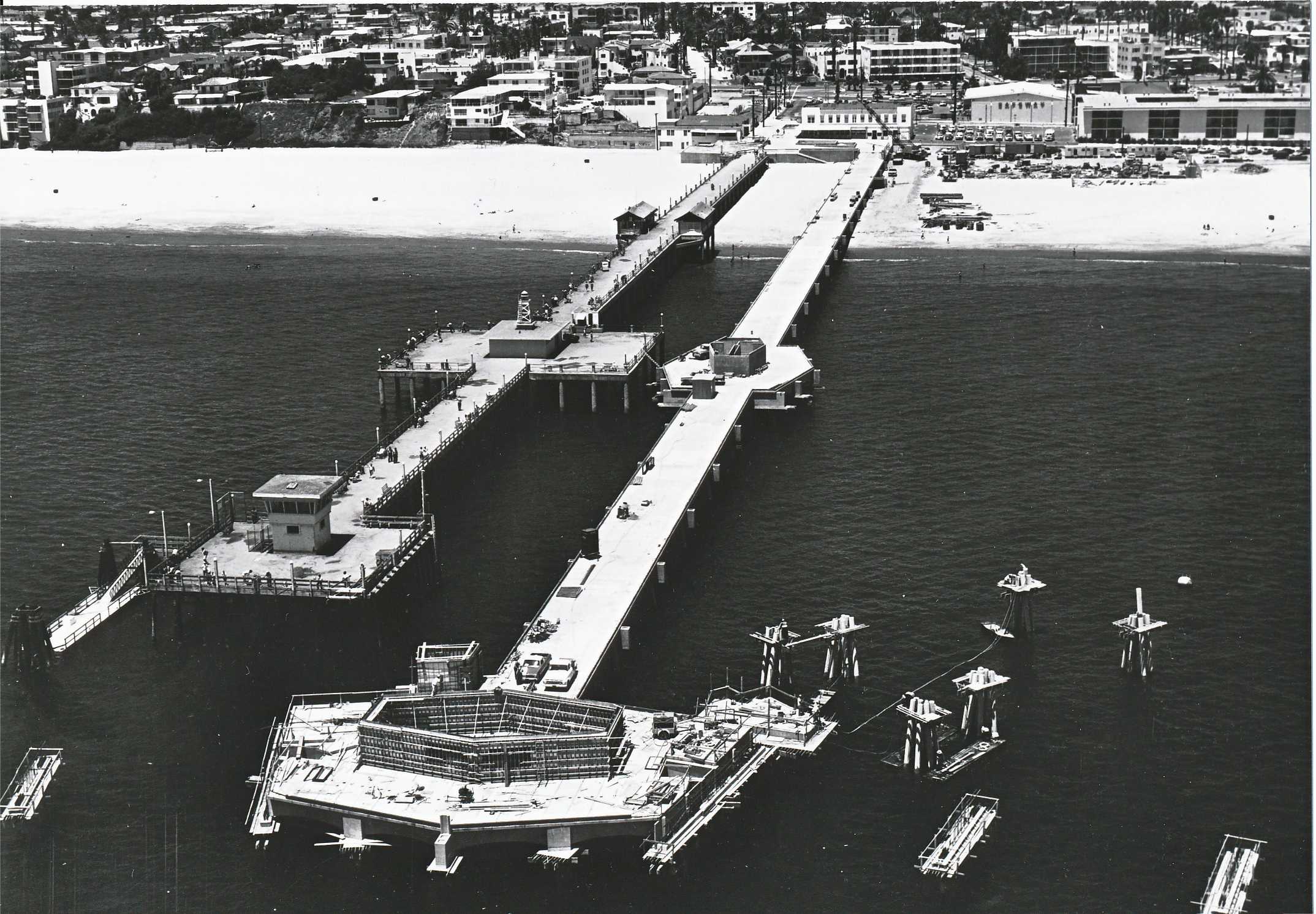
The Grand Avenue/Belmont Heights/Devil’s Gate Pier opened on Christmas Eve 1915 and was seen as a payback gift from the Long Beach municipality to the residents of the Belmont Heights section of town (an area that was mainly tidal flat and far from the center of action). Locals had earlier asked the city to fund a pier but been refused. In response, the residents formed a new city—the City of Belmont Heights—which meant Long Beach would lose the local taxes from the area. Long Beach leaders had a change of heart, agreed to build the pier, and the area rejoined Ling Beach.
The pier was 975-foot-long and had a maximum width of 112 feet in the middle and a minimum width of twenty-five feet. Ornamental lights illuminated the pier and in the middle were two pergolas. Newspapers reported that 3,000 to 4,000 people visited the pier the first two days it was open and that 500 to 600 automobiles drove out to the end on the smooth concrete surface.
Barge fishing was available by the mid-‘20s with the introduction of the James McKenna (1925 to postwar). The barge Rainbow (AKA Makaweli) joined the mix in 1935, and the Point Loma was operating from the pier in 1940. Several different sportfishing boats and barges operated from the pier over the years, although their use would be curtailed during World War II. Nevertheless, fishing barges returned soon after the war and by 1947 five operated from the pier: the Kilroy, New Rainbow, Fox, Hemlock and Bounty (AKA Martha Buehner). In 1951 the pier was renovated and given a 300-foot extension.
Long Beach…Barges, $1 per day, reached by boat from Belmont Pier at S. end of 39th Pl.; departures at 2-1/2 hr. intervals, 8-a.m.-3 p.m.; prices include bait and tackle. Surf and pier fishing.
—California, A Guide To the Golden State, Federal Writers Project, Works Progress Administration, 1939
1947 Newspaper Ads
DEEP SEA FISHING
Day Or Nite
On The Live Bait Barge
“FOX”
A 145 Footer with a 35 foot beam
A Good Spot To Spend An Enjoyable Day’s Outing,
Plus Good Fishing
Staterooms • Comfortable Lounge
Good Galley Service * Tackle Store
Rental Tackle Available
Shore Boats Leave Daily From
BELMONT PIER
Foot of 39th Pl., Long Beach, Caif.
For Schedule Tune in “Fishing Facts” Over KFOX Each Mon. at 8 P.M.
And Thurs at 9 P.M. or Call Long Beach 860-21
Largest Fishing Barge On The Coast
Deep Sea Fishing Barge
“HEMLOCK”
BELMONT PIER * LONG BEACH
Foot of 39th Pl.
Excellent Accommodations * Galley * Day and Night Fishing
Regular Boat Service Daily Between Barge and Pier
Call Long Beach 875-95 for Information
The “BOUNTY”
One of the Outstanding Fishing Barges
Located in Ideal Fishing Grounds a short run from
Belmont Pier, Long Beach, Calif.
Excellent Accommodations • Capacity 200 Passengers • Good
Galley • Lounge Room • Sun Deck • 6 Staterooms • Tackle Store • Rental Tackle • Flood Lights for Night Fishing
Live Bait Boats also on Daily Schedule
BELMONT SPORT FISHING CO.
Belmont Pier, Foot Of 39th. Pl. Long Beach
Hdq. Belmont Tackle Store
Free Parking Ph. Long Beach 876-17 or 864-61
Fish and Game Bulletin i#96 dated 1953 makes note of the fact that “The city has had, throughout the years, several pleasure piers for anglers. At Belmont Shore there is now a modern pier. In 1952 there were 22 party boats and 64 charter boats out of Long Beach. Five fishing barges were anchored offshore.”
By the 1960s the older pier was in poor condition and the decision was made to build a new pier. One week after the new pier opened, the demolition of the old pier began (and plans included placing part of the rubble from the older pier around the new pilings, thus acting as an artificial reef).
On Sunday, February 19, 1967, the new 1,450-foot-long Belmont Pier opened and the local newspaper’s headline read “Throngs Hail Opening of New Pier.” The story reported that free live bait was given out all day long and recorded the initial catches at the new pier. The first fish officially caught was by an eleven-year-old girl, Rosemary Rodriguez, who caught a sand bass. Brian Williams, a four-year-old angler was the youngest to catch a fish—a bullhead. The oldest was 82-year-old Albert Parbst who caught a perch. The largest fish of the day was a 2-pound, 8-ounce bonito caught by 16-year-old Maureen Younger.
Among the pier’s amenities in those days was a Sportfishing fleet that operated from the 336-foot, Y-crossing at the seaward end. The Queen of the Sea operated as a half-day boat and the Hurricane operated as a three-quarter day boat. For many years it was possible to catch The Islander which served as a water taxi to take anglers out to the 150-foot-long barge Annie B.
Many of the old-timers feel that the fishing has gone down since those days, a fact which they contribute to pollution of the bay’s water and to the change in the mix of the pier’s anglers. Many of the pier’s regulars today are Latino and Asian and many are subsistence fishermen fishing for food (even though the food may not be particularly safe to eat). Since most of the fish, regardless of size, are kept, the population of larger fish probably has decreased. However, those who have the know-how still catch fish, including some that are pretty decent size. Today’s mix of anglers also represents, I believe, a change in the focus of the pier. The pier has become a family pier where regulars and their families will be found most days, especially non-school days. Some may protest this mix but activity at the pier is actually mellower and certainly less destructive than that in the late ’70s and ’80s and a change, I believe, for the better.
Plans were announced early in 2002 for the closing and renovation of the pier beginning in the fall or winter of 2002. Among the changes was the name. The rechristened pier became the Belmont Veterans Memorial Pier!
Plans called for tearing down all the current buildings and building new structures and it was said the pier could be closed for a year. The name did change, and some changes were made, but the pier stayed much the same. However, in 2017 new plans were discussed.
Long Beach eyes replacing Belmont Pier for Olympic sailing events
One of Los Angeles’ key selling points to win the bid for the 2028 Olympic Games was the array of existing, or soon to be existing, venues throughout the area.
Already in place are the Los Angeles Memorial Coliseum, which will be hosting the games’ opening ceremonies for the third time, plus facilities at UCLA and USC, the Rose Bowl, Dodger and Angel stadiums, Staples Center, StubHub Center, the Forum and, in Long Beach, the newly refurbished arena and, to provide the viewing area for sailing competitions, the Belmont Veterans Memorial Pier.
The pier is problematic, and, in its current state, there’s a good chance it won’t be around for the international event 11 years down the road.
Instead, the city is looking into the feasibility of either a thorough rehabilitation of the 1967 structure or, more likely, the construction of a new pier in time for it to serve as the viewing site for one of the Summer Olympic’s most photogenic events. “There’s no question that the pier needs major work right now,” said Long Beach Mayor Robert Garcia in an interview Thursday. “It’s in massive need of repair. It’s underutilized, and we’re going to come up with a plan to make it a great showcase for the city.”
In addition to the expected wear that comes from the elements, the pier sustained serious damage during the recent winter storms, including one on Feb. 17, which caused the Aqualink water taxi dock and the lower mooring dock to become detached and wash up onto the beach, where they were declared a total loss. The pier was closed for two weeks for repair. Concrete, too, has cracked and broken in several places and recently the wings jutting out from the end of the pier had to be closed for repair work.
“Even if the Olympics weren’t coming, it was something we were going to have to start looking at,” said Garcia. “But the sailing event being held here in Long Beach gives us a little push. We’re going to need to have a serious conversation during the course of next year about whether we’re going to repair it or rebuild it to make the pier become one of the great things in our community.”
A few years ago the city conducted a preliminary look at the pier; the conclusion was it’s nearing the end of its useful life, said Assistant City Manager Tom Modica. “So we have already been discussing the options of whether to repair or rebuild the pier,” Modica said. “It’s most likely we will rebuild it, because it would probably cost about the same as repairing it.”
Modica said a rough estimate for the cost of a new pier would be $25 million to $35 million. Already on the books is $200,000 in Tidelands funds set aside for a feasibility study, which Modica says will be getting started in the next year. He added the city will also be talking to the L.A. Olympics officials to see if there is any available money to use for a new pier.
—Tim Grobaty, Long Beach Press-Telegram, August 5, 2017
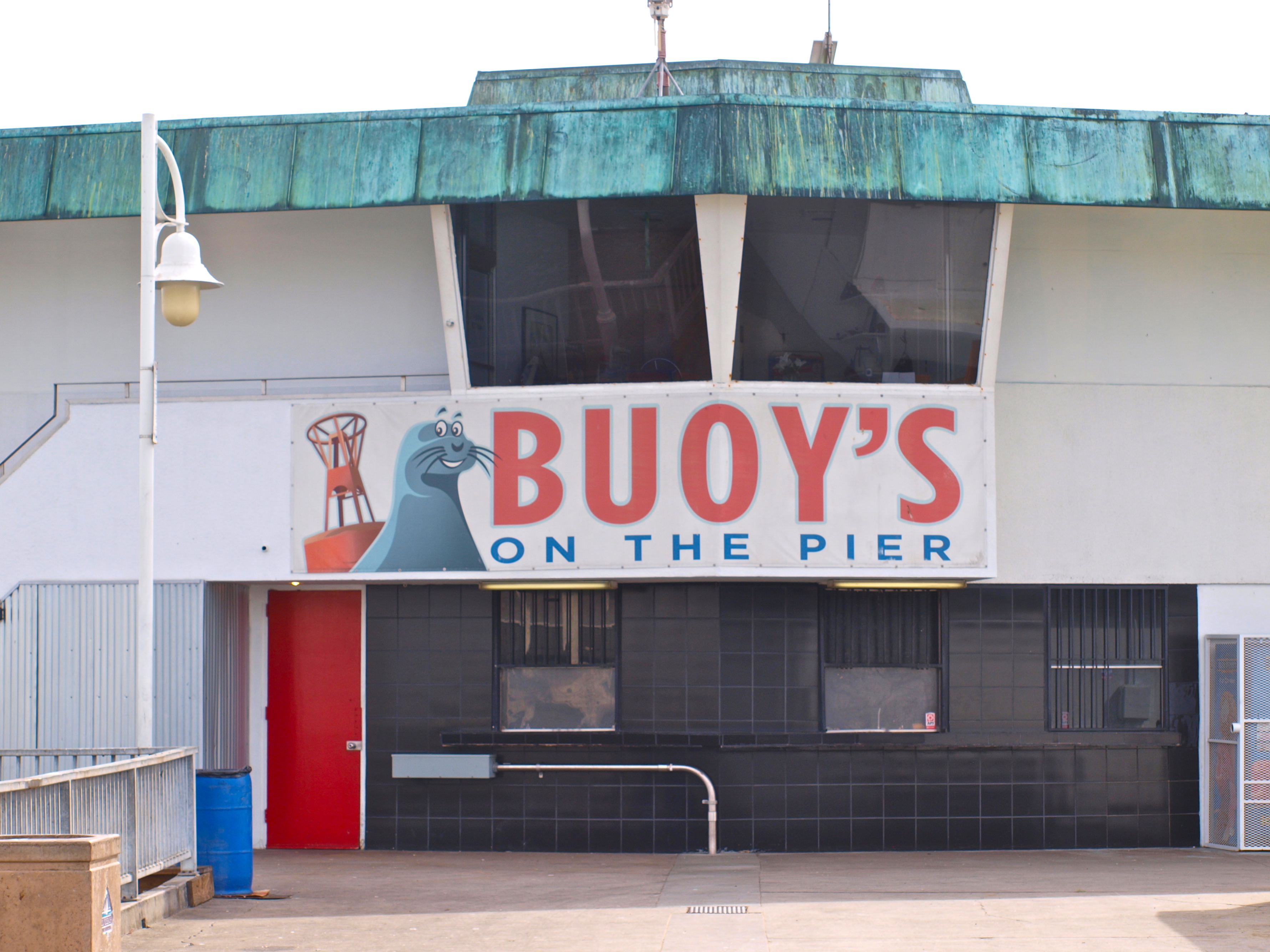
Belmont Shores Pier Facts
Hours: Open from 5 A.M. till sundown.
Facilities: Lights, some benches, fish-cleaning stations, portable toilets restrooms, and a bait and tackle/snack shop (that’s rarely open) are located on the pier. There is a parking lot near the foot of the pier ($.50 an hour with a 10 hour limit, no parking 6:30-7:30 A.M. on Tuesdays, and no parking from 12 midnight until one hour before sunrise). Both free and metered parking on adjacent streets.
Handicapped Facilities: Some handicapped parking in the parking lot at the foot of the pier. The pier is wheelchair accessible with a railing 42 inches high.
Location: 33.7564577805144 N. Latitude, 118.14889311790466 W. Longitude.
How To Get There: From the north take I-405 to the Lakewood Boulevard turnoff, and then go south to 7th Street, turn west (right) until you come to Ximeno Ave. and then turn left. Follow it to Livingston Dr. and go west. You will see signs by Ocean Ave. and Termino Ave. indicating the pier. From the south take the Pacific Coast Highway to 2nd. Street (Westminister becomes 2nd. Street when it crosses PCH), go west, follow to Livingston Dr. Follow it to signs by Ocean Ave. and Termino Ave. indicating the pier and parking lot.
Management: City Of Long Beach.
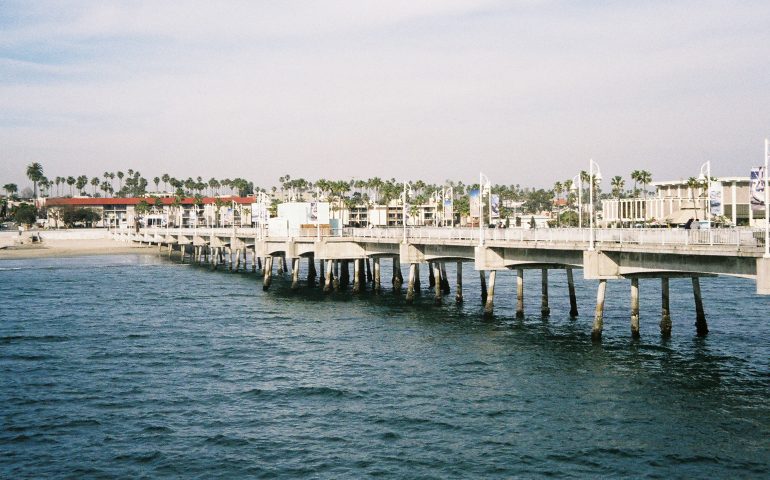
Hello, I was wondering if you know the source of the image found above the passage that starts with: “The Grand Avenue/Belmont Heights/Devil’s Gate Pier opened on Christmas Eve 1915”. If it is under your copyright, or you would be willing to share your source, please reach out. Thank you!
WOW!! The good old Annie B fishing barge. I worked for the Annie B barge, named for
Annie Berube (unsure of spelling) who along with her husband Paul were partners in
the venture along with Billy Verna after whom the shore boat was named, the Billy V.
Mr. Verna also owned the Bill’s bait barges in the harbor.
I started out as just a deck hand on both the barge and the boat eventually getting a
simple 50 ton inland masters license after which I became a barge master on the
where I actually lived upstairs full time. I was still working as a deck hand on the
Billy V under the tutelage of a fantastic man named George Edwards. Soon after, I
became one of the boat captains of the Billy V where we ran visitors to the barge
from Belmont Pier and from Ports ‘o Call 9n addition to running whale watch
cruises. All while still living on the barge including during the week as the barge
was only open on Fri, Sat and Sun. Had to barge all to myself and loved it.
Anyway, I eventually went on to work operating water taxis and other boats
in the LA/Long Beach Harbor.
By far, some of the best memories of my life
I admire how you’re able to tackle this with such grace and understanding. Well done!
This article really captures the charm and significance of the Belmont Shores Pier in Long Beach. I’ve visited the pier several times, and each visit feels like a new experience. The blend of natural beauty with the local culture is unbeatable, whether you’re strolling along the pier, fishing, or just taking in the breathtaking ocean views. I loved reading about the pier’s history—it’s amazing to think how it has stood the test of time and continues to be such an iconic spot for locals and tourists alike.
The fishing tips in this article were also spot on. As someone who enjoys fishing, I’ve always wondered about the best spots along the pier, and the advice on fishing techniques will definitely help me make the most of my next trip. Plus, the pier is so family-friendly with activities for everyone, whether you’re a fisherman, a nature lover, or just someone looking to relax by the water.
It’s clear that the Belmont Shores Pier holds a special place in the community, and I can see why. I can’t wait to go back soon and make more memories! Thanks for sharing such a detailed and informative article!